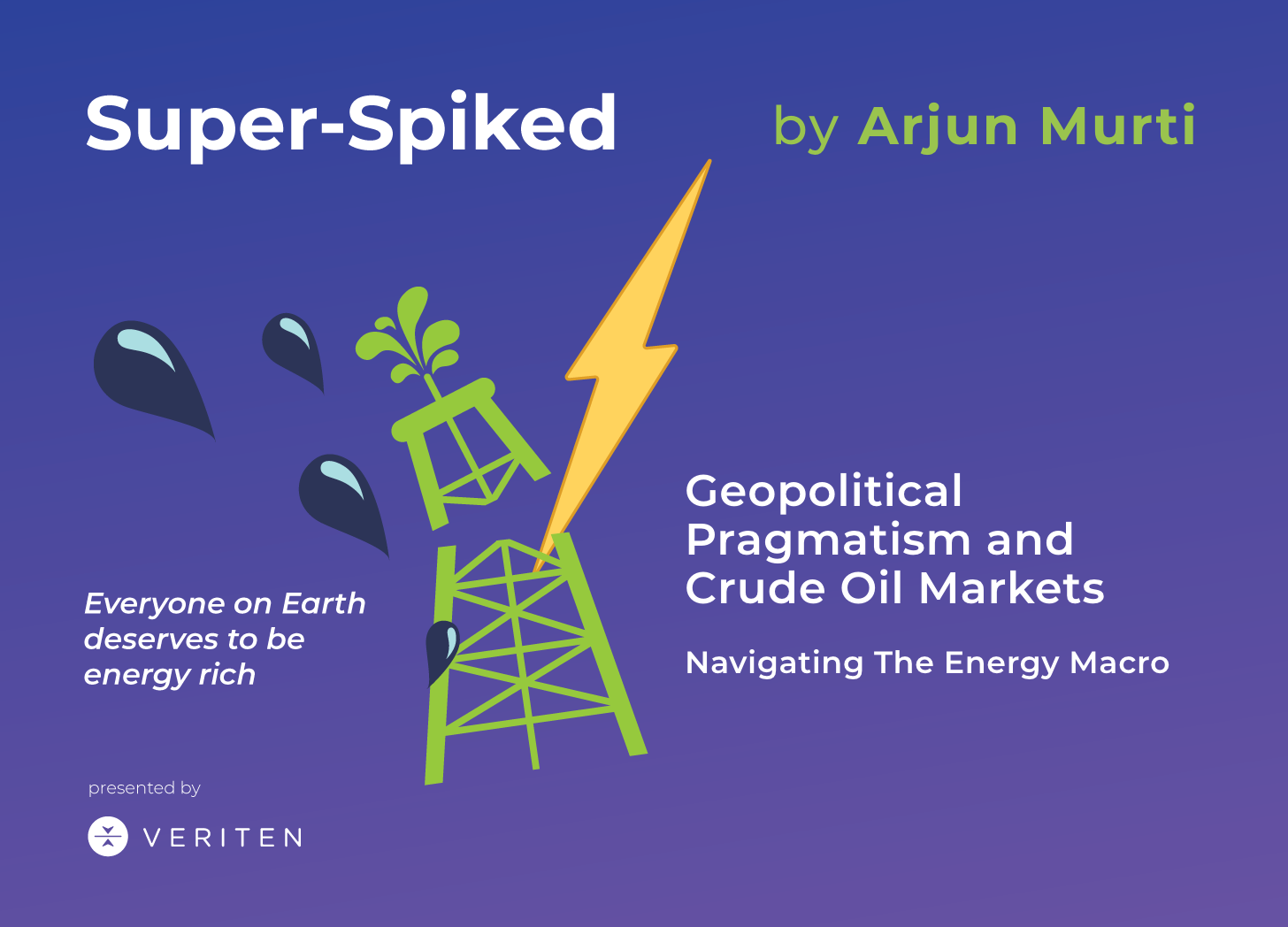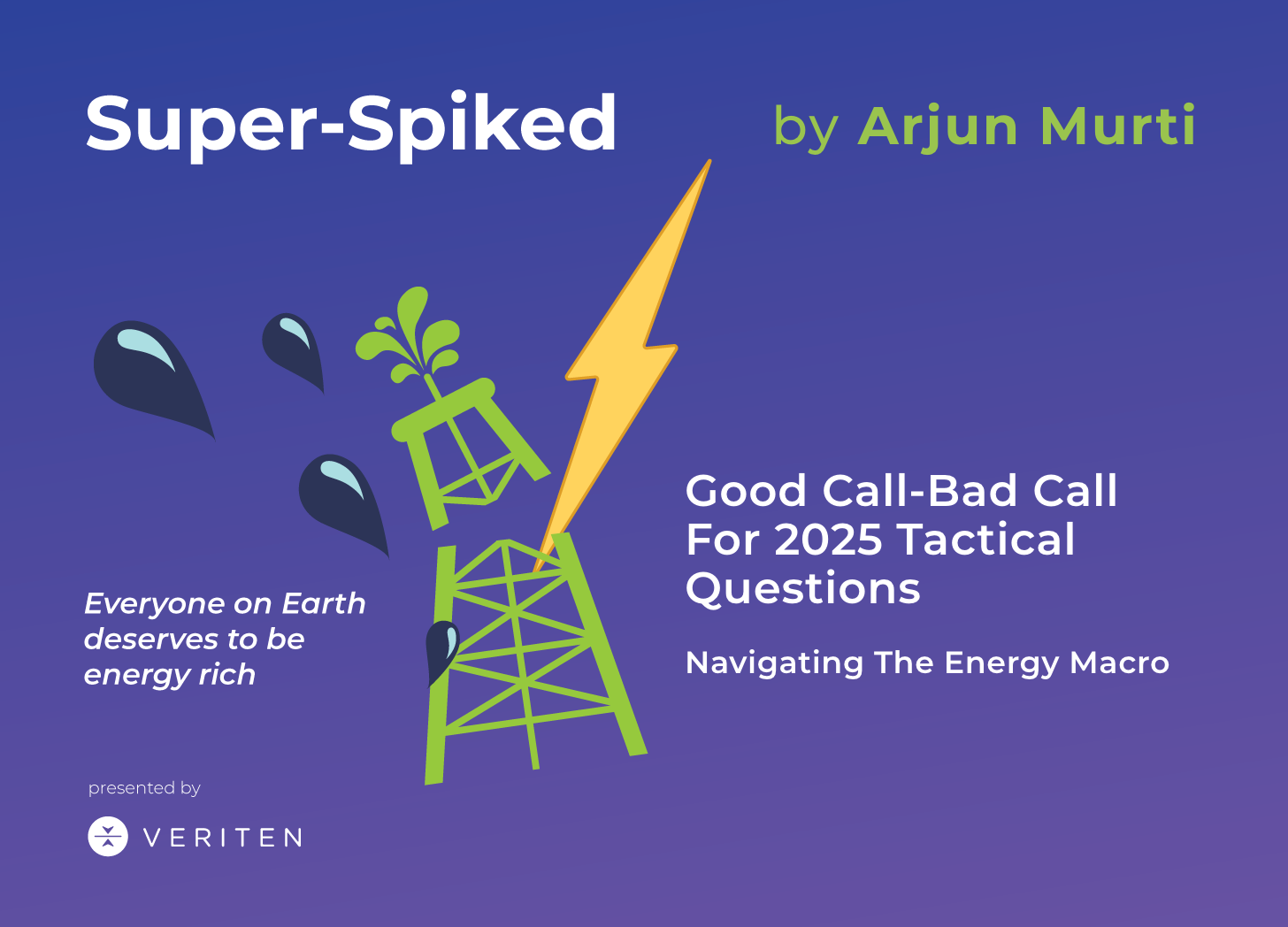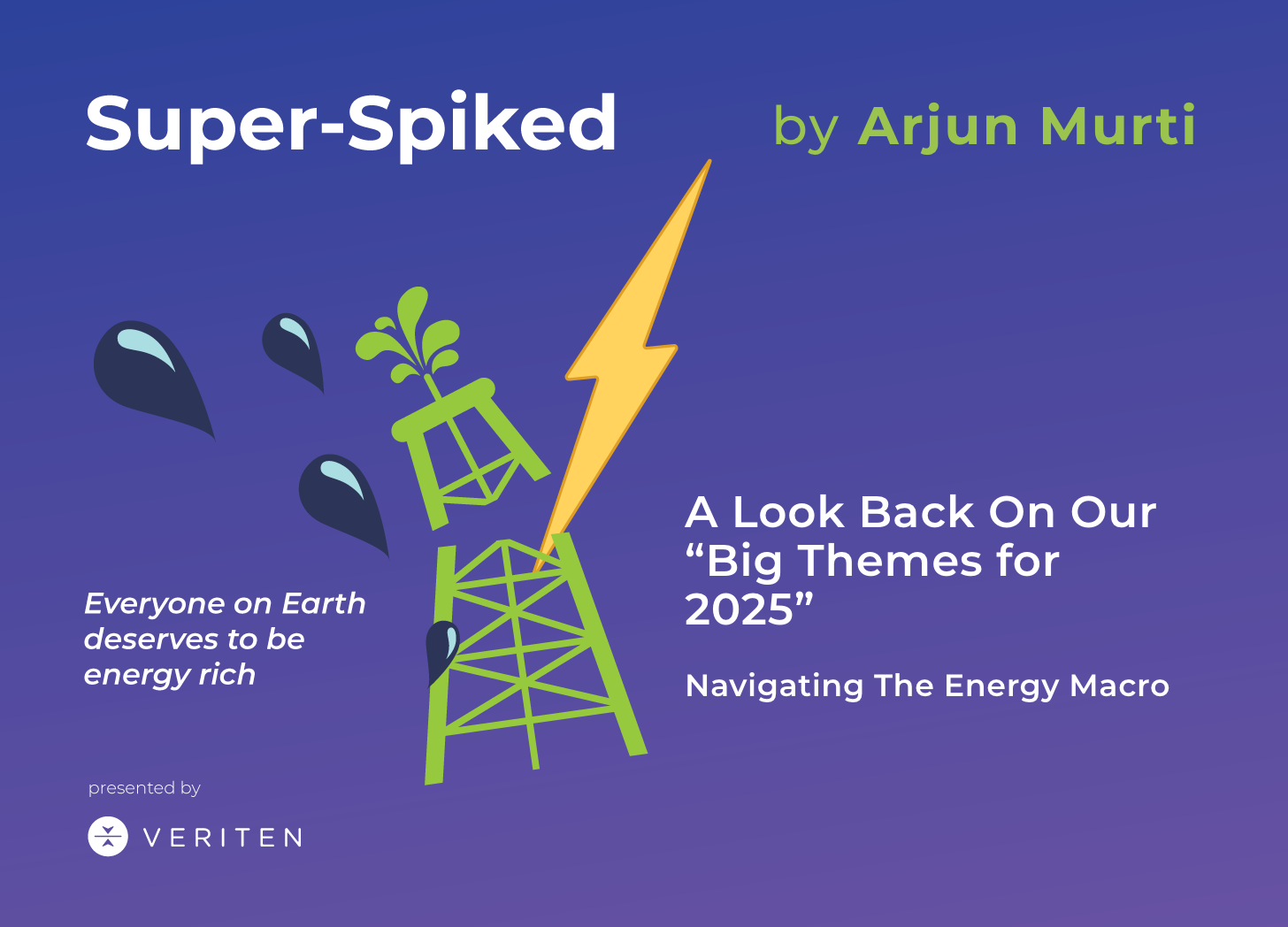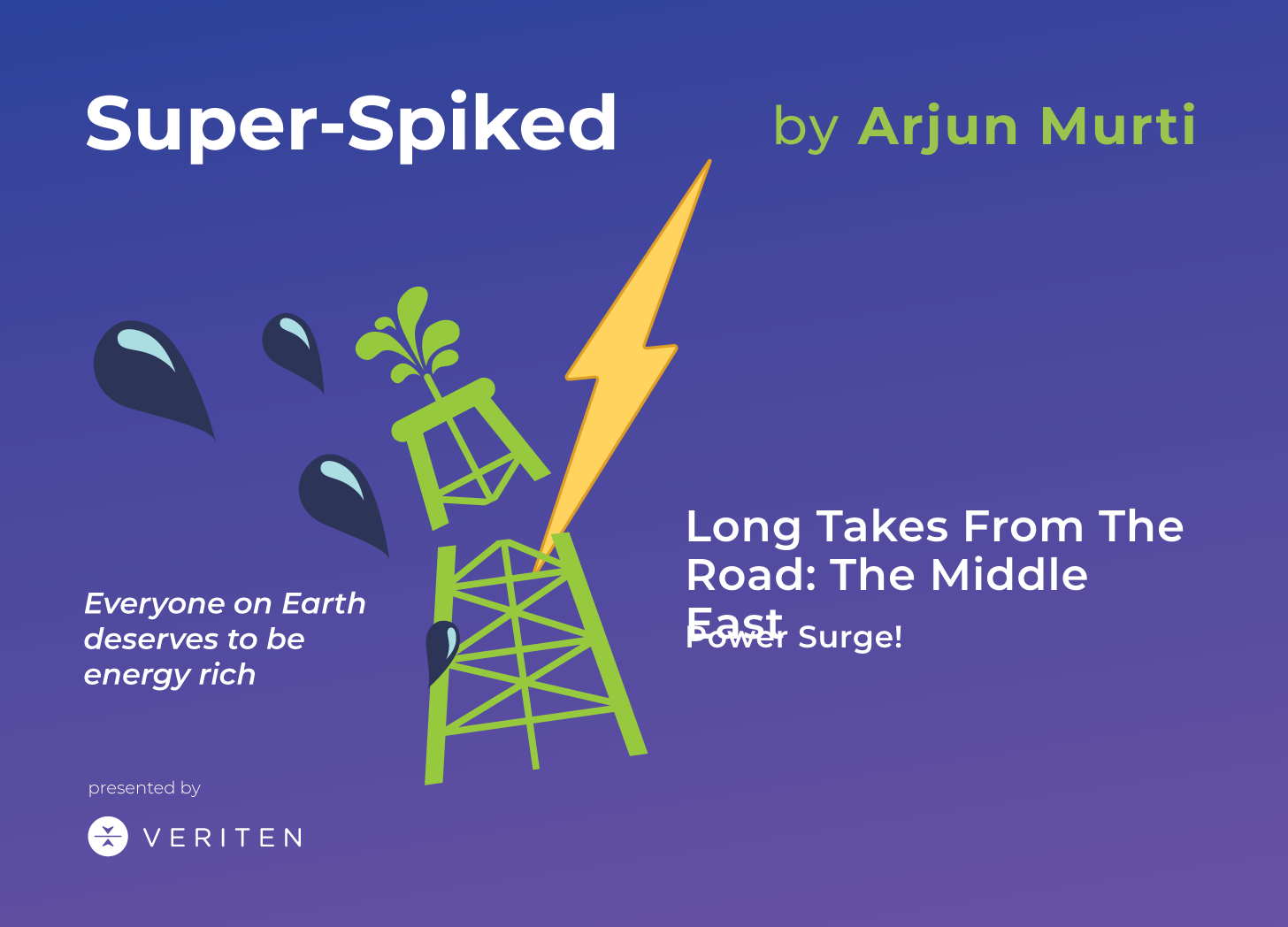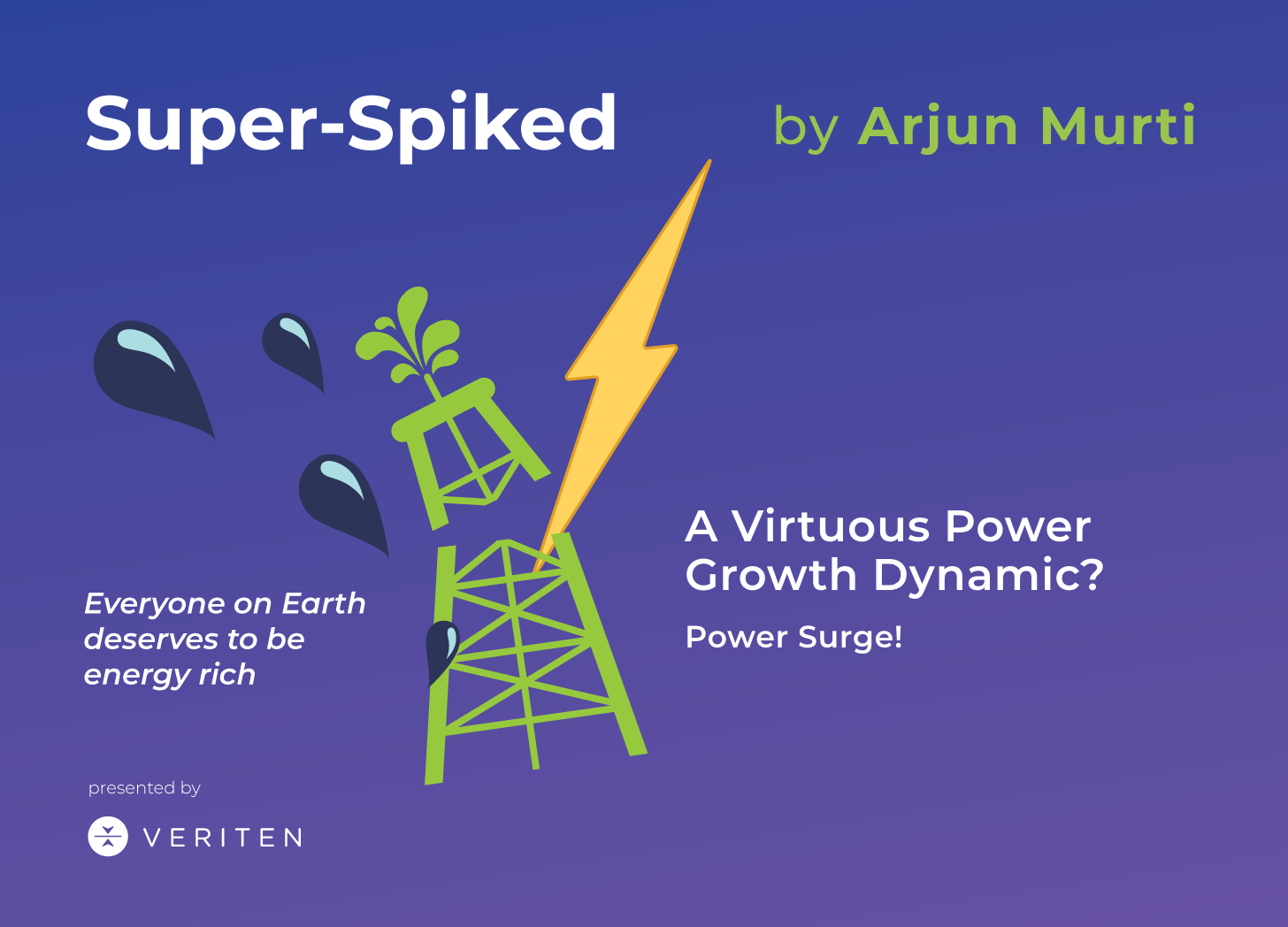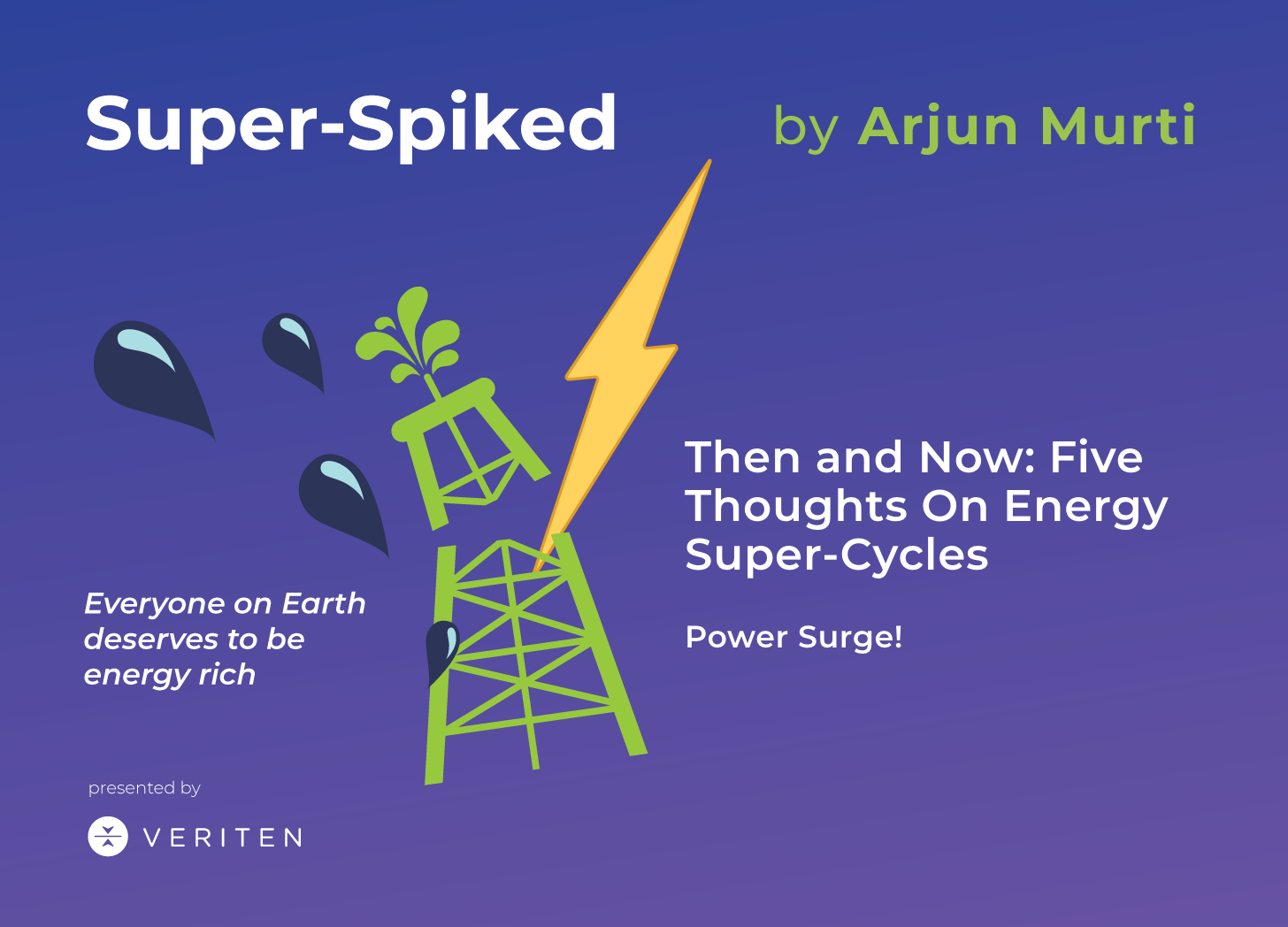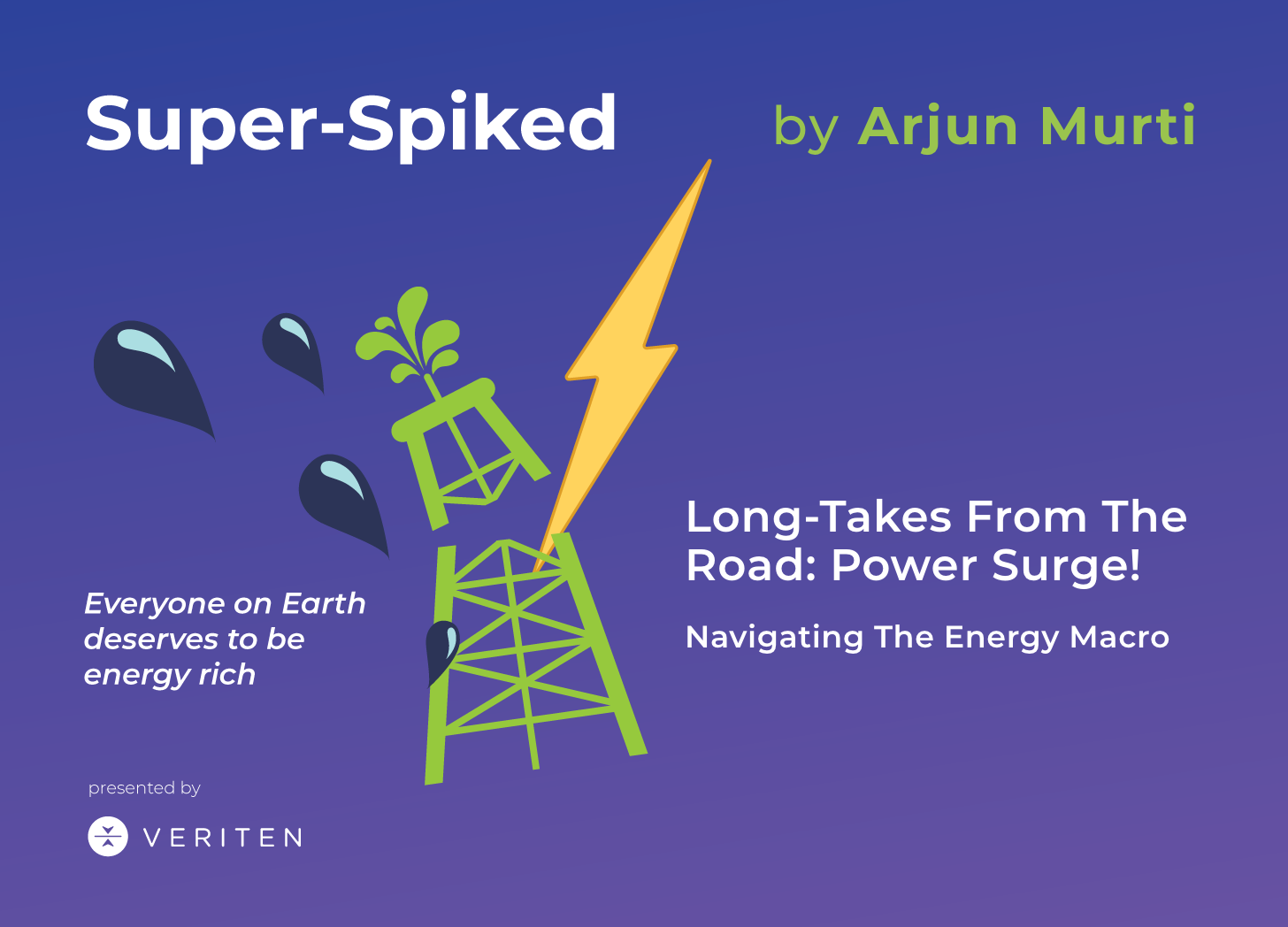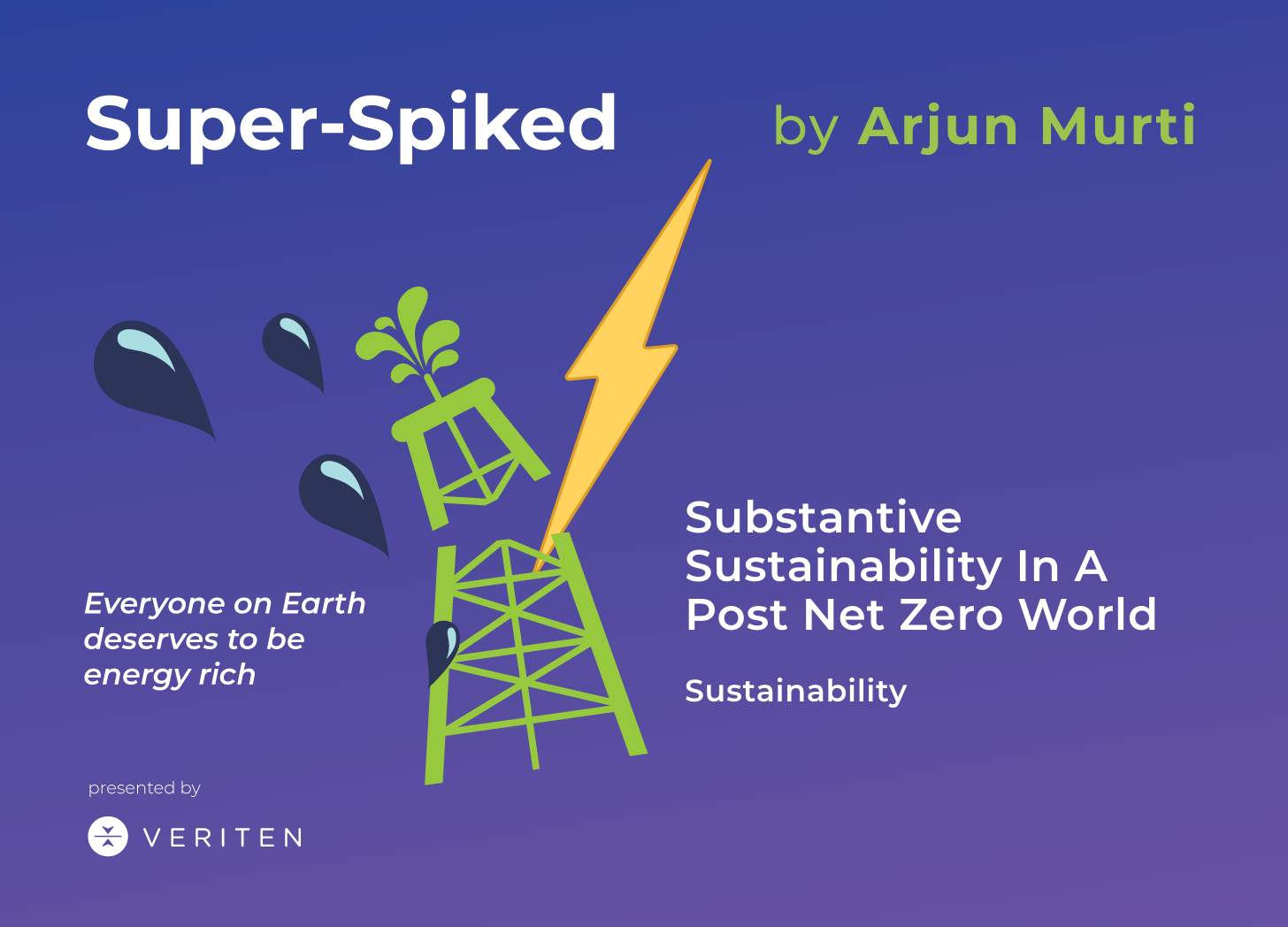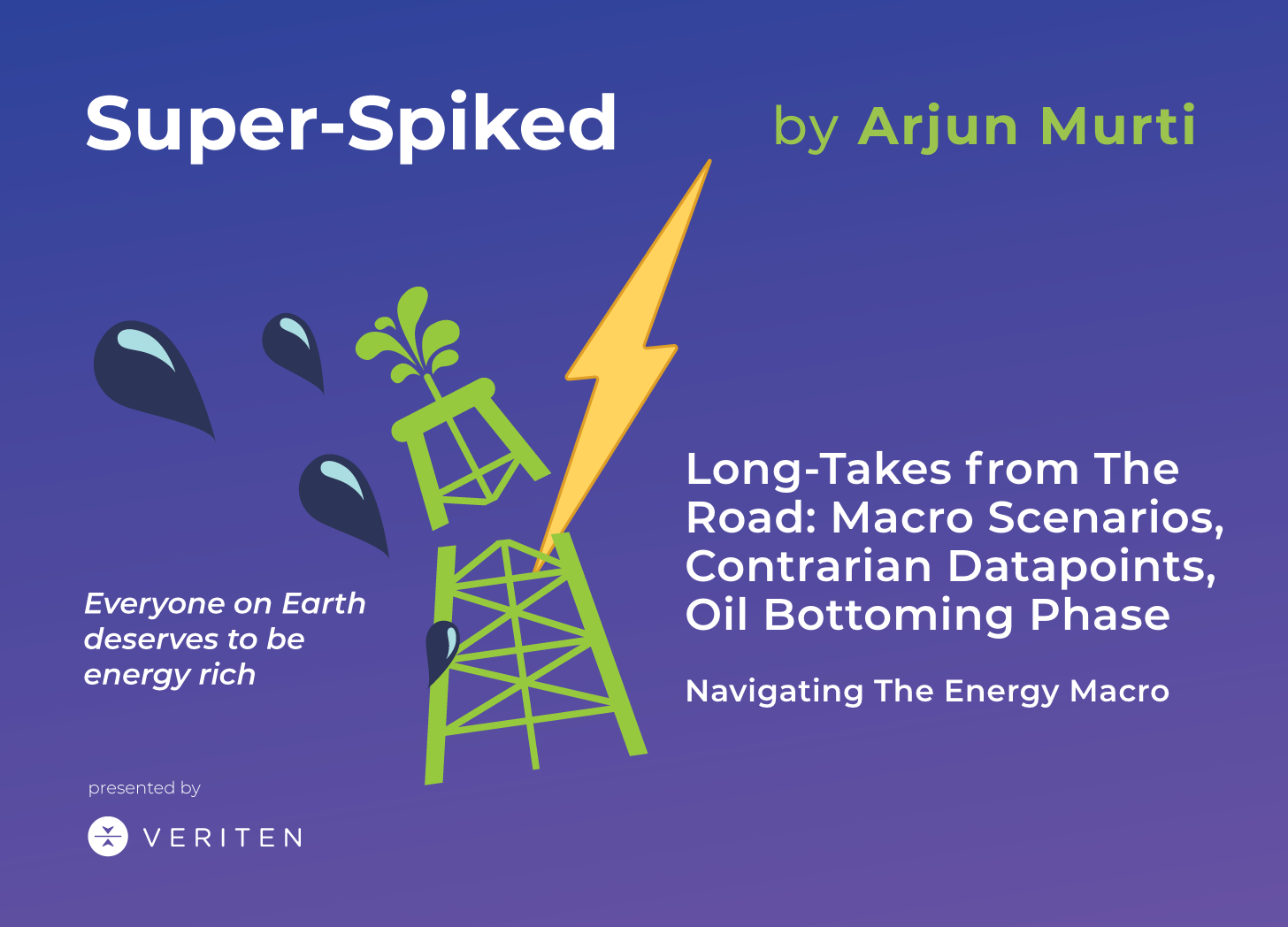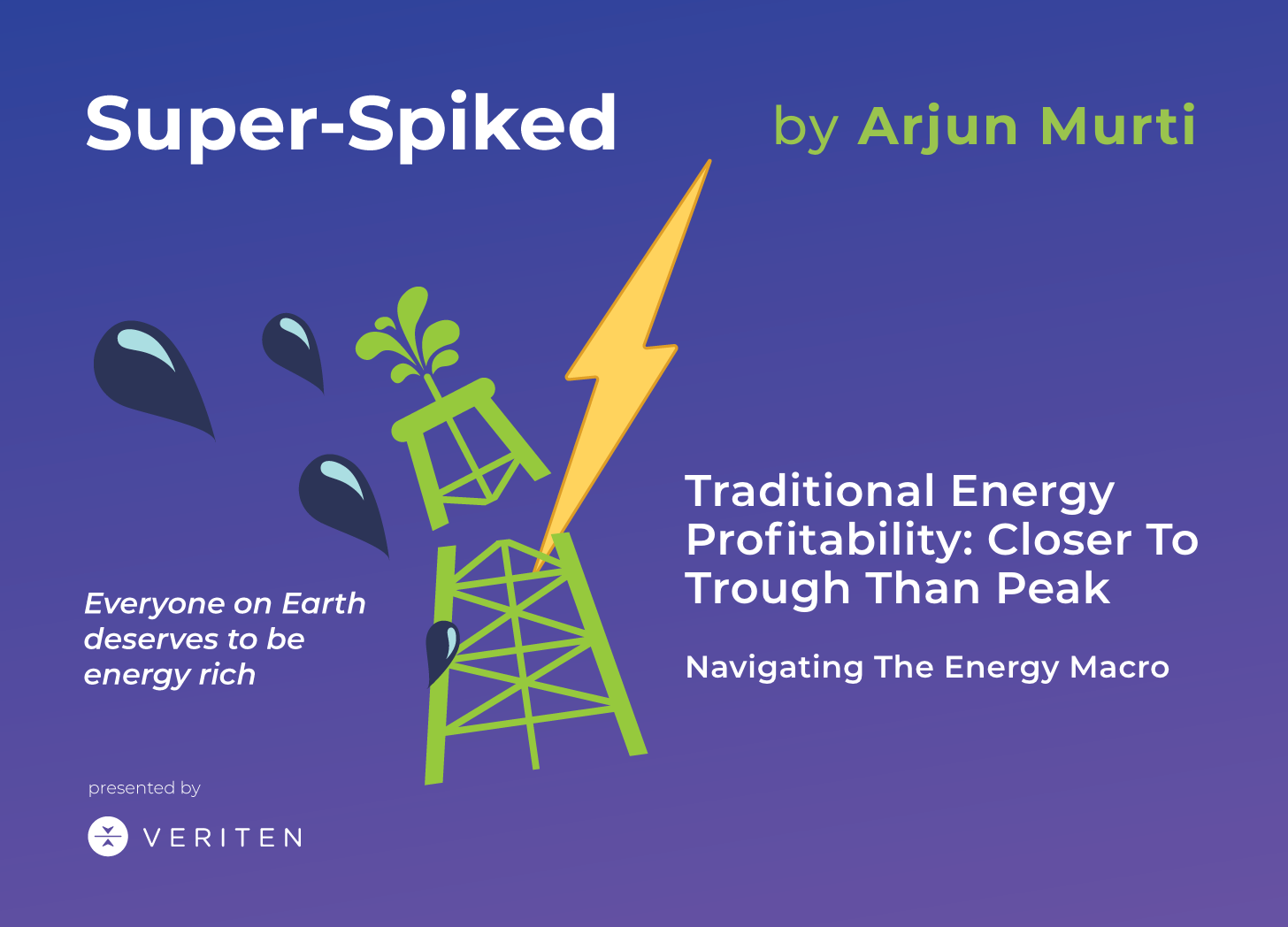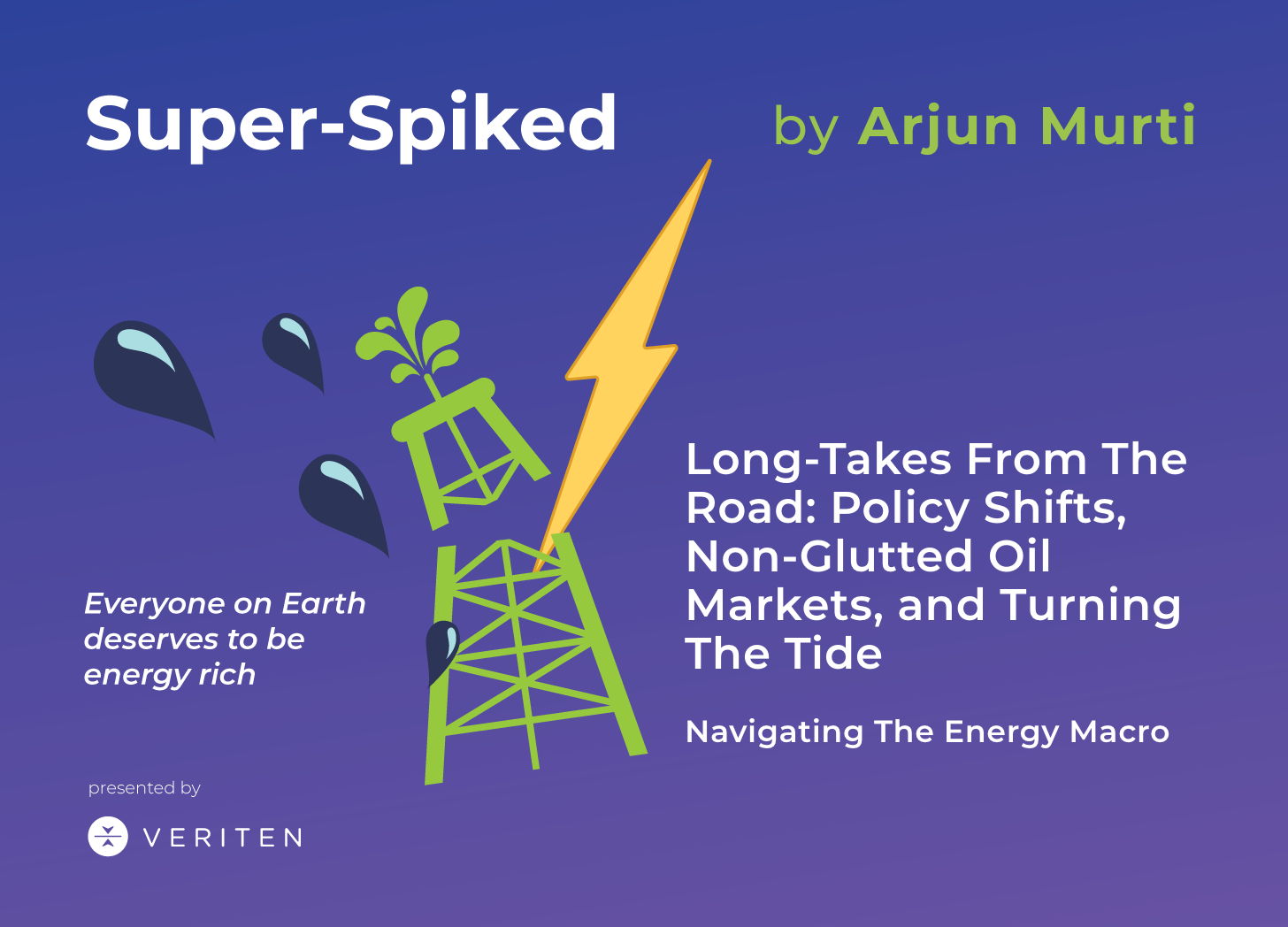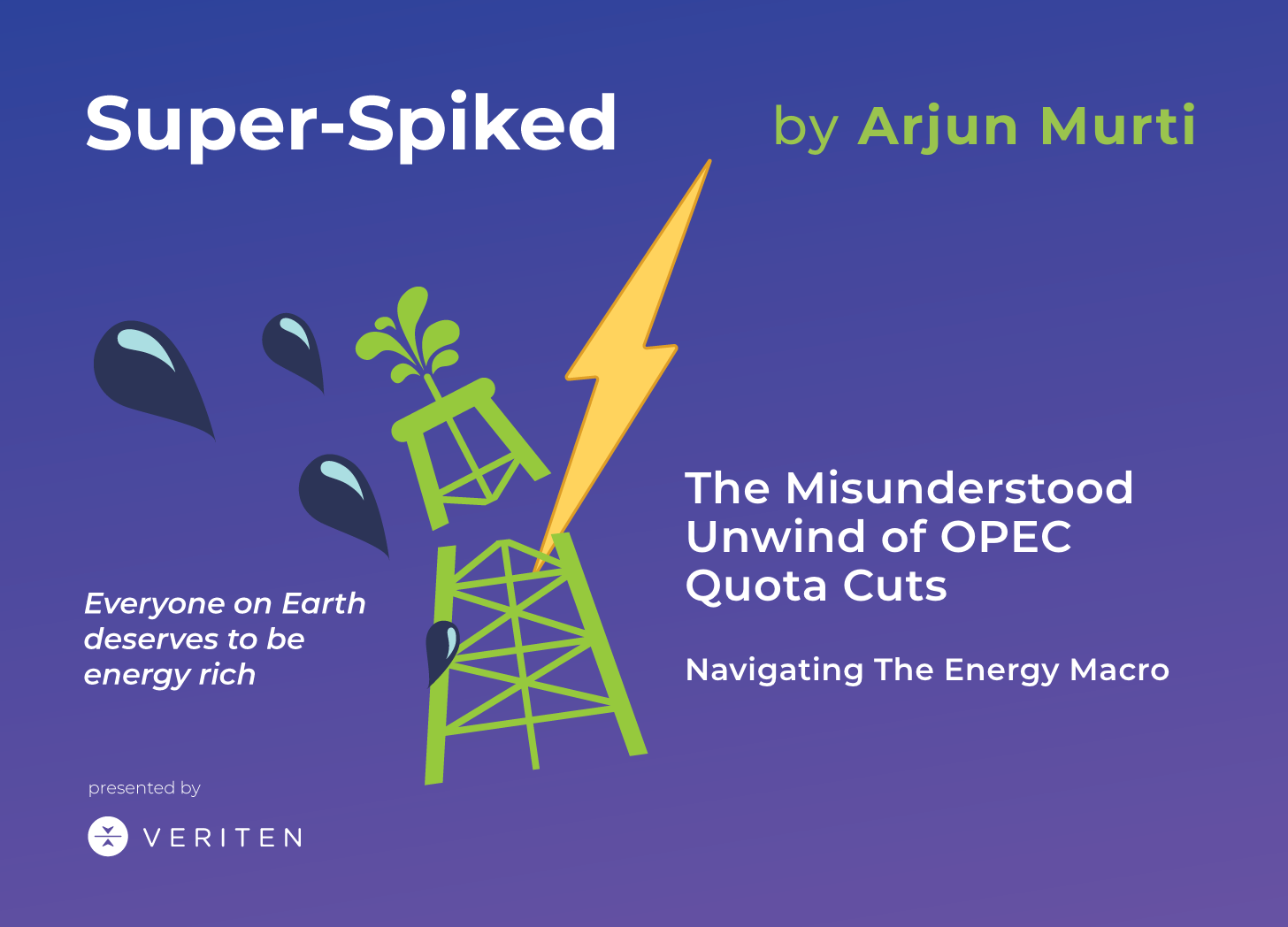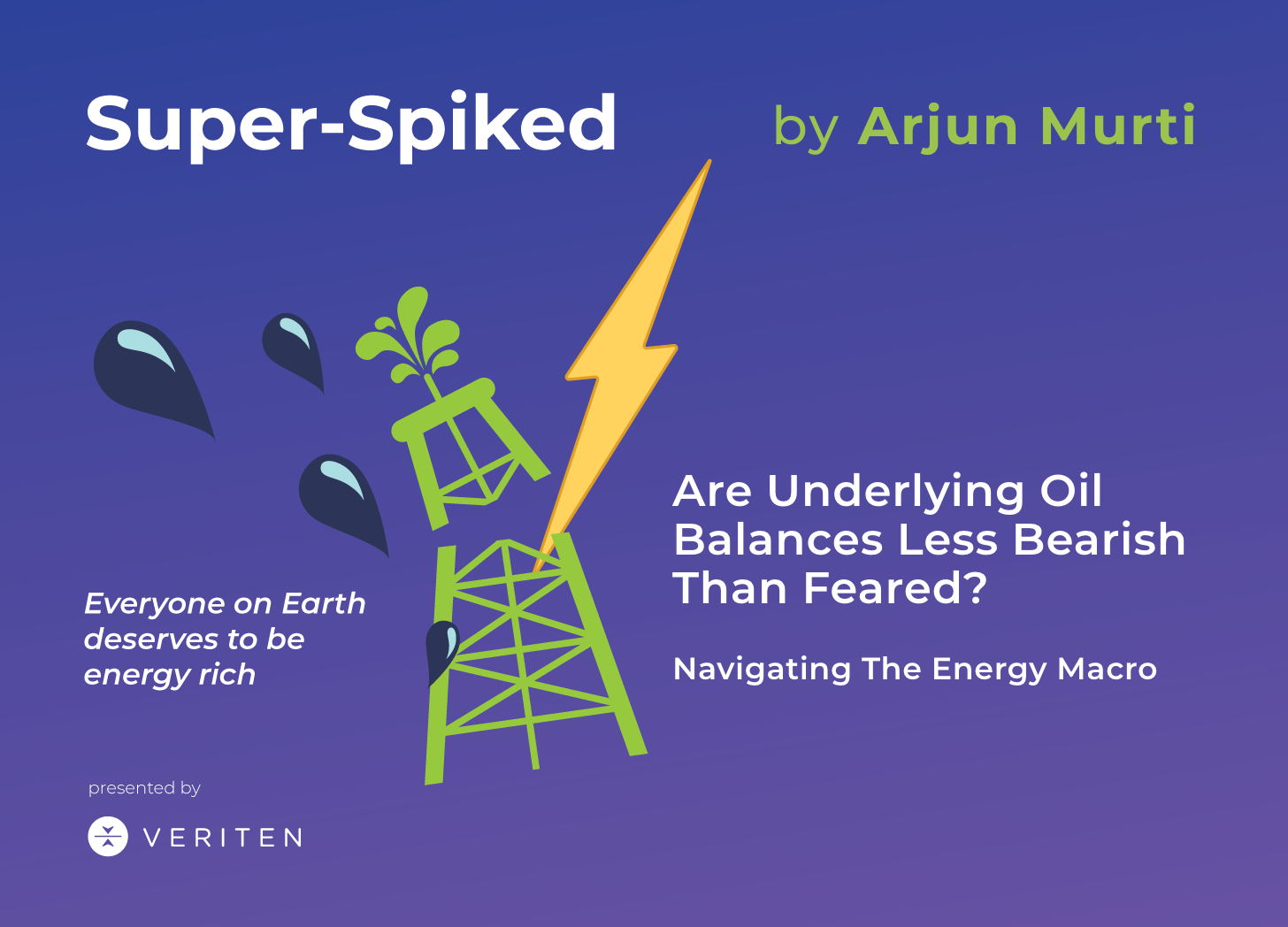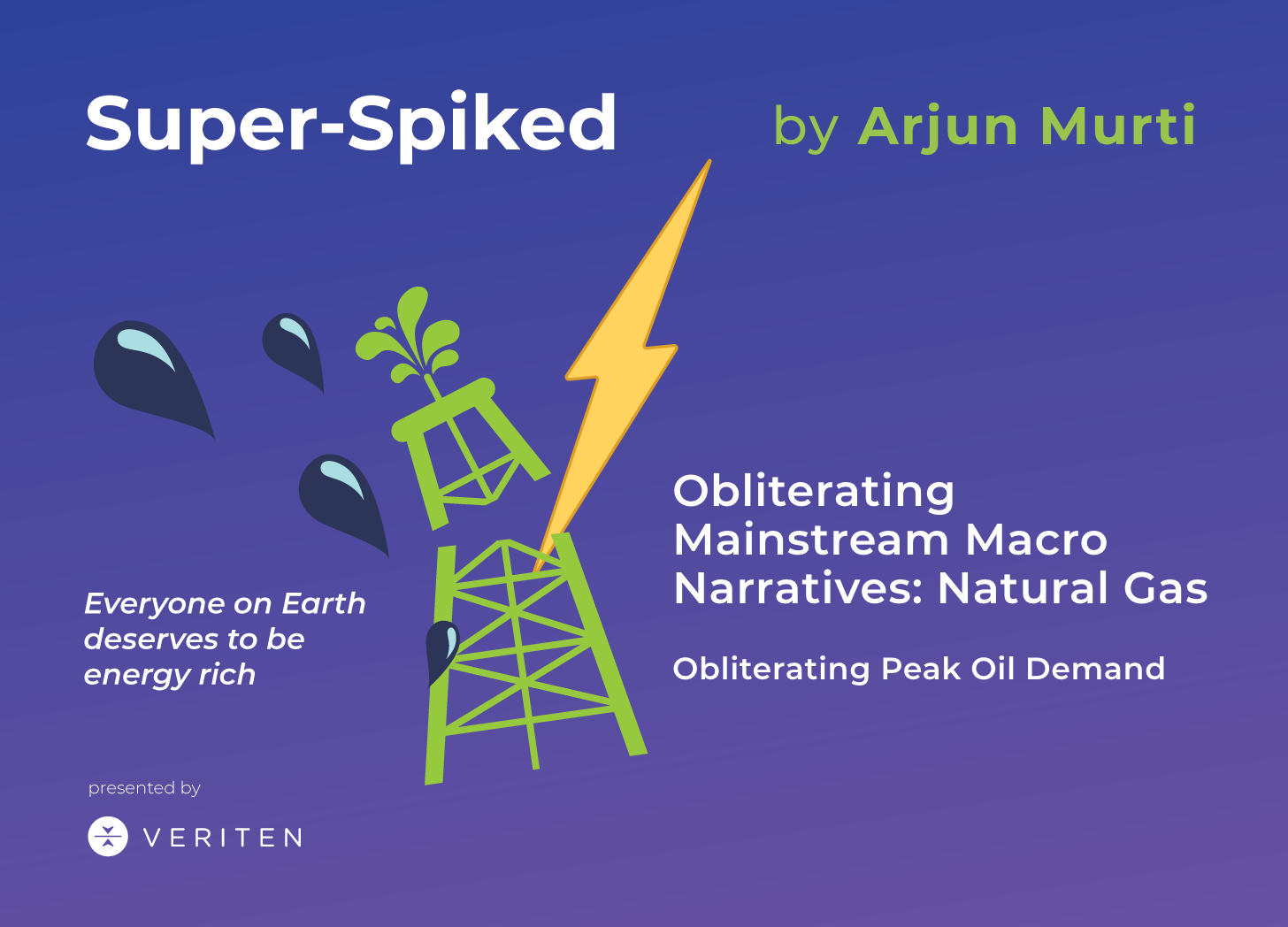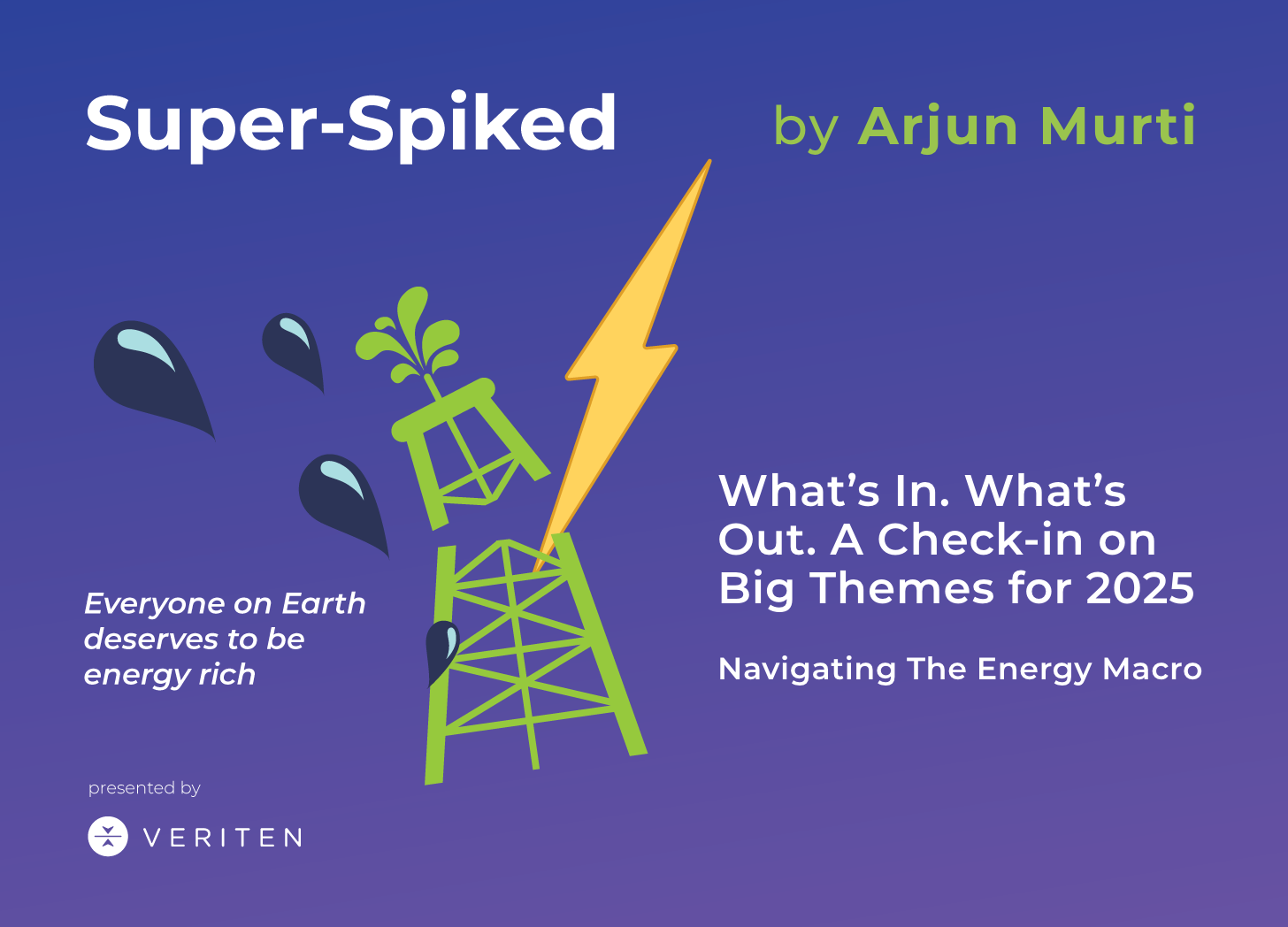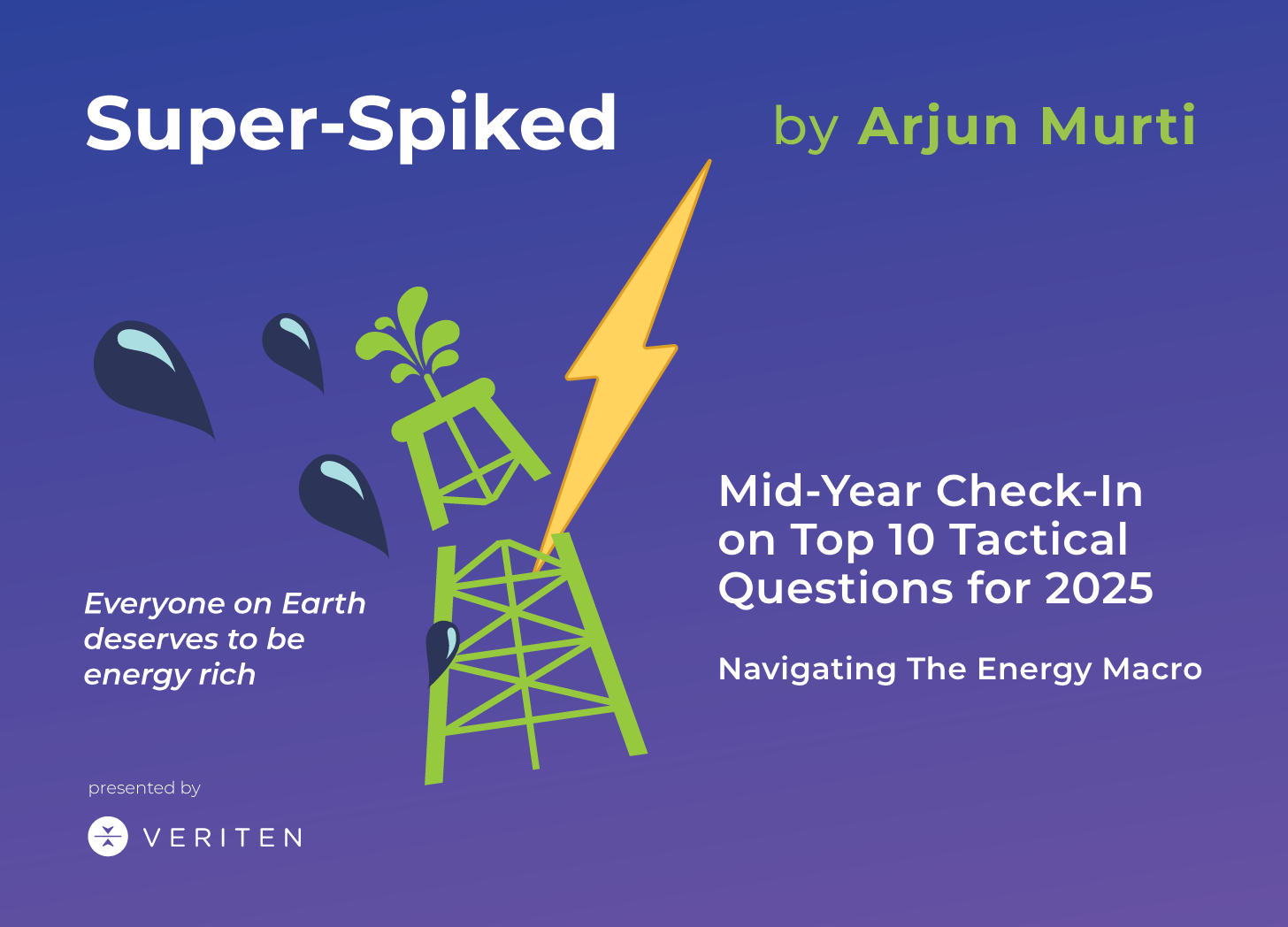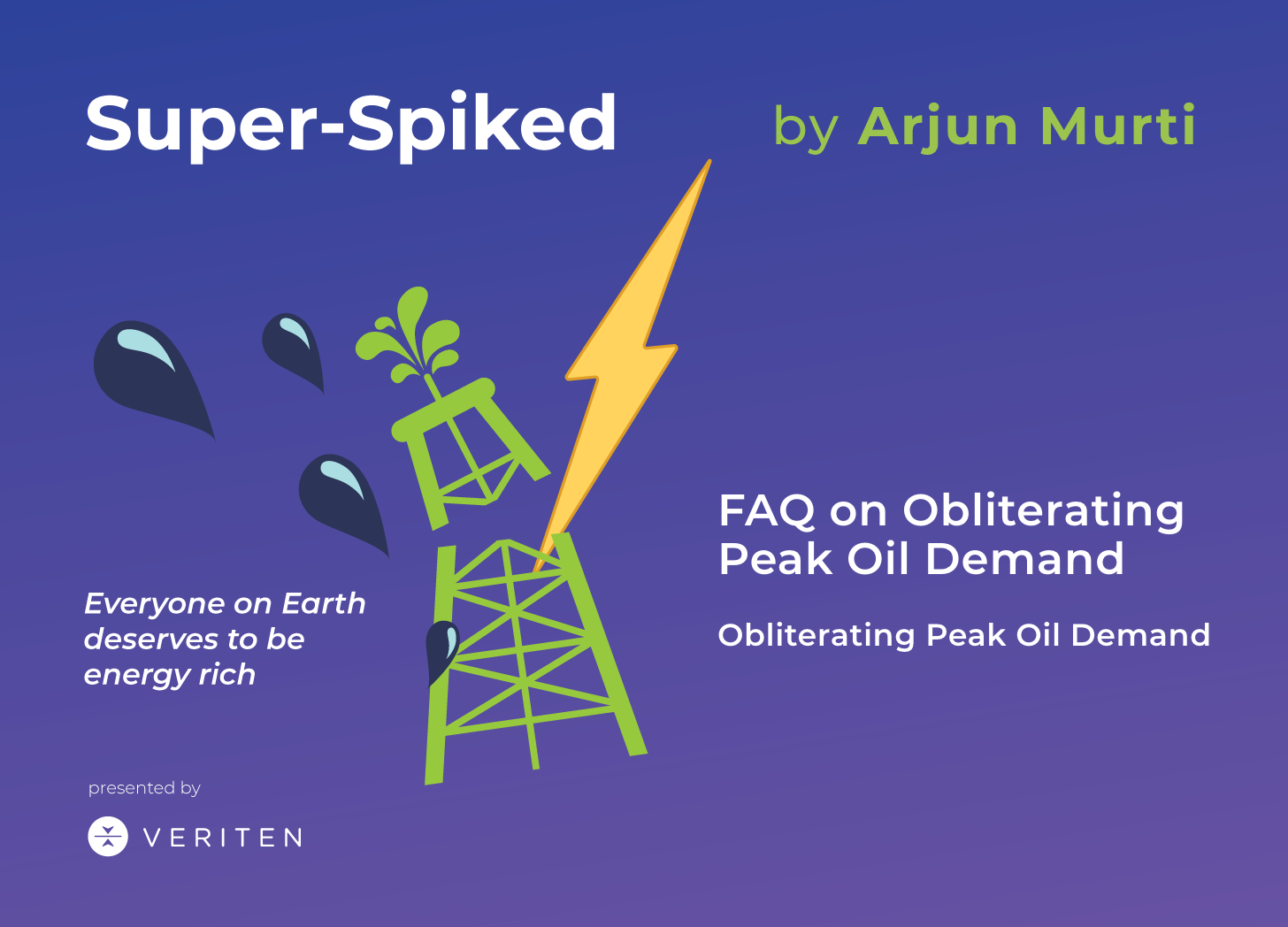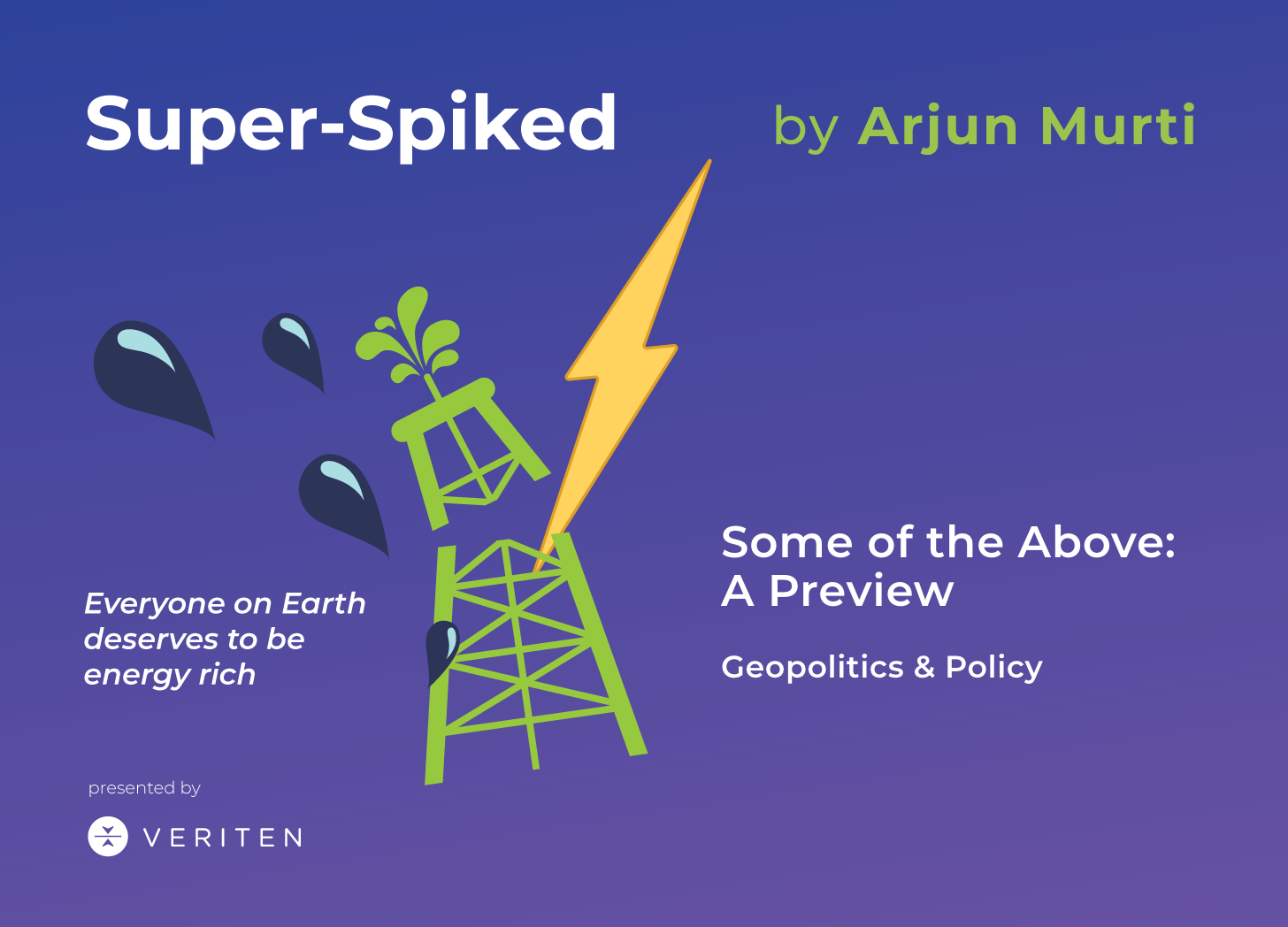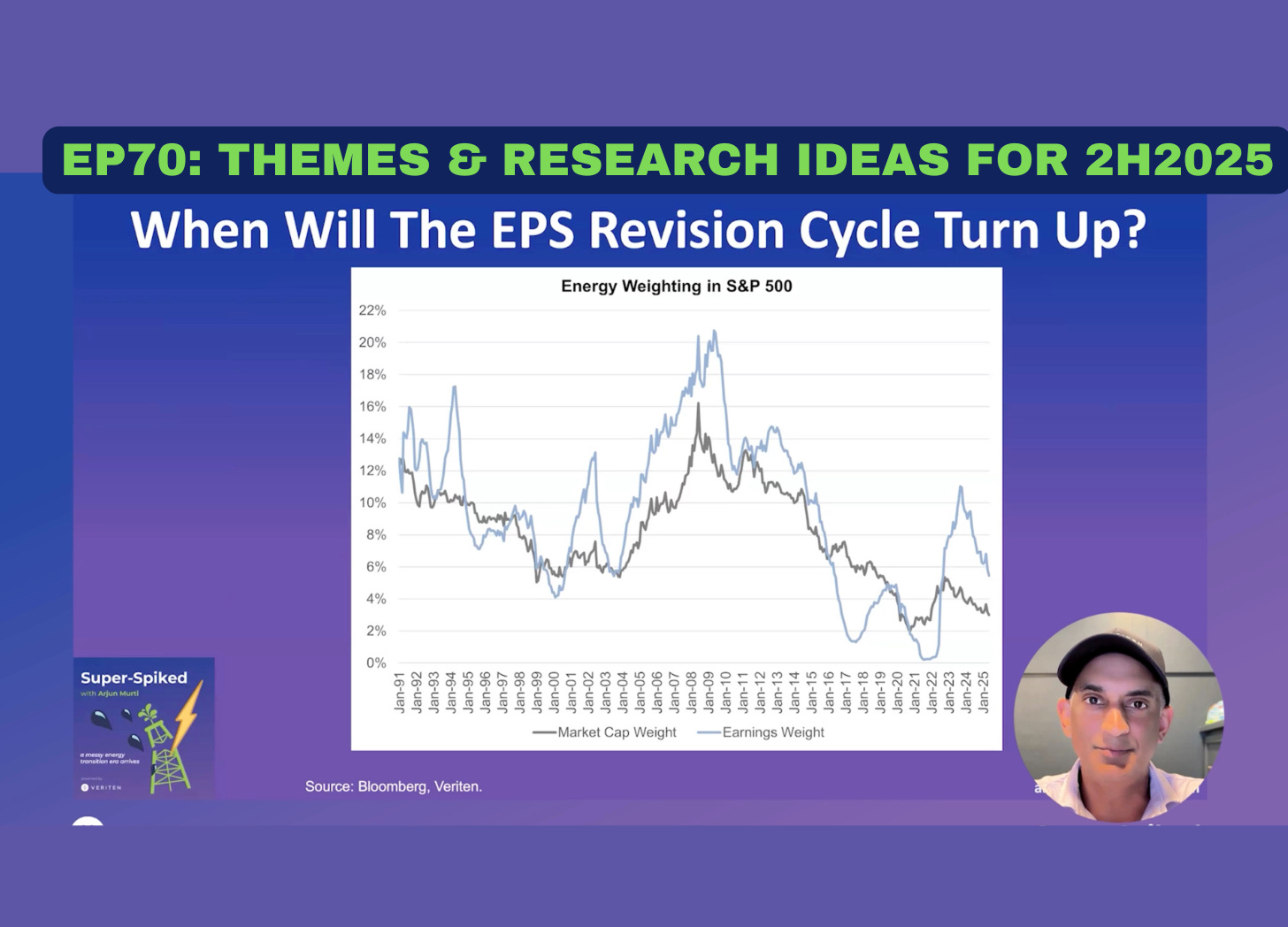Discover Super-Spiked Podcast
Super-Spiked Podcast

Super-Spiked Podcast
Author: Arjun Murti
Subscribed: 18Played: 856Subscribe
Share
© Arjun Murti
Description
Super-Spiked Podcast focuses on the mission of everyone on Earth someday becoming energy rich and what that would mean for corporate strategy and energy & environmental policy, markets and commodities
arjunmurti.substack.com
arjunmurti.substack.com
91 Episodes
Reverse
For Super-Spiked subscribers that prefer that written posts, we have included a lightly edited transcript of the video (blue download button below) along with a downloadable copy of the slide deck.WATCH the video on Substack by clicking the play button above or on YouTube (here).STREAM audio only on Apple Podcasts (here), Spotify (here), or your favorite podcast player app.DOWNLOAD a pdf of a lightly edited transcript and the slide deck using the blue Download buttons below.2026 kicked off with the dramatic news of the US’s incursion into Venezuela and capture of its president Nicolas Maduro. Protests against the ruling regime in Iran have also captured the world’s attention. We will aim to put those events into the context of our long-term oil macro view, which of course is our focus at Super-Spiked. As a reminder and as a disclaimer, we look at these events through our lens as an energy equity research analyst and a current partner at Veriten. There is no commentary in this video about specific companies.⚡️On A Personal Note: RIP Bob Weir🔔 4 Ways to Subscribe* All Content: If you subscribe to Super-Spiked via email, you will receive all content to your inbox and it is also all on the Super-Spiked website. I have been aiming to publish about once a week, usually on Saturday.Subscribe to Super-Spiked to receive all content via email.* Veriten: You can also subscribe to Super-Spiked content via the Veriten website (here) and receive Veriten’s flagship COBT video podcast.* YouTube channel for video only: You can subscribe directly to the video feed ofSuper-Spiked Videopods on my YouTube channel Super-Spiked by Arjun Murti.* Apple Podcasts, Spotify for audio only. You can subscribe directly to the audio only feed on Apple Podcasts, Spotify or your favorite podcast player app. The podcast is simply the audio for the YouTube videos.📜 Credits* Intro & Outro music: Wolf Hoffman: Concerto for 2 Cellos in G Minor, Rv 531: I. Allegro Moderato.* This episode of Super-Spiked Videopods was edited and produced by Veriten Productions.⚖️DisclaimerI certify that these are my personal, strongly held views at the time of this post. My views are my own and not attributable to any affiliation, past or present. This is not an investment newsletter and there is no financial advice explicitly or implicitly provided here. My views can and will change in the future as warranted by updated analyses and developments. Some of my comments are made in jest for entertainment purposes; I sincerely mean no offense to anyone that takes issue This is a public episode. If you would like to discuss this with other subscribers or get access to bonus episodes, visit arjunmurti.substack.com
For Super-Spiked subscribers that prefer that written posts, we have included a lightly edited transcript of the video (blue download button below) along with a downloadable copy of the slide deck.WATCH the video on Substack by clicking the play button above or on YouTube (here).STREAM audio only on Apple Podcasts (here), Spotify (here), or your favorite podcast player app.DOWNLOAD a pdf of a lightly edited transcript and the slide deck using the blue Download buttons below.Last week’s video podcast was a look back on our Big Themes for 2025 that we highlighted in January (here). We did pretty well with the 3 main themes, but not so good on 4 sub-topics we teased. We will aim to be better targeted on what we highlight for 2026. This week we evaluate how we did on our “Top 10 Tactical Calls” that we published in late January (here). We use a “Good Call” or “Bad Call” framework to assess how we did. Spoiler alert: Overall we did well, but were far from perfect. Finally, we do a broader assessment on how we are feeling about major Super-Spiked themes and topic areas after what has now been 4 years of publishing. What are we proud of, what if anything are we not, and what are we thinking looking ahead. We heard from many of you that appreciated that we did a proper assessment of our calls. Someone even said we were a tough self-grader. It baffles us why everyone doesn’t take this approach. Companies put out targets or promises, Wall Street analysts make calls and publish outlook reports, academia and policy shops do their own version of opinion making. All those groups, in our humble opinion, would benefit from doing their own self-assessment. People like them! It’s popular. It builds credibility and accountability. This will be our final Super-Spiked of 2025. We will return most likely on January 10th. On behalf of everyone associated with Super-Spiked and Veriten, we wish you and your families a Happy Hanukkah, Merry Christmas, Happy New Year, and a great Holiday Season!!!🔔 4 Ways to Subscribe* All Content: If you subscribe to Super-Spiked via email, you will receive all content to your inbox and it is also all on the Super-Spiked website. I have been aiming to publish about once a week, usually on Saturday.Subscribe to Super-Spiked to receive all content via email.* Veriten: You can also subscribe to Super-Spiked content via the Veriten website (here) and receive Veriten’s flagship COBT video podcast.* YouTube channel for video only: You can subscribe directly to the video feed ofSuper-Spiked Videopods on my YouTube channel Super-Spiked by Arjun Murti.* Apple Podcasts, Spotify for audio only. You can subscribe directly to the audio only feed on Apple Podcasts, Spotify or your favorite podcast player app. The podcast is simply the audio for the YouTube videos.📜 Credits* Intro & Outro music: Wolf Hoffman: Concerto for 2 Cellos in G Minor, Rv 531: I. Allegro Moderato.* This episode of Super-Spiked Videopods was edited and produced by Veriten Productions.⚖️DisclaimerI certify that these are my personal, strongly held views at the time of this post. My views are my own and not attributable to any affiliation, past or present. This is not an investment newsletter and there is no financial advice explicitly or implicitly provided here. My views can and will change in the future as warranted by updated analyses and developments. Some of my comments are made in jest for entertainment purposes; I sincerely mean no offense to anyone that takes issue. This is a public episode. If you would like to discuss this with other subscribers or get access to bonus episodes, visit arjunmurti.substack.com
For Super-Spiked subscribers that prefer that written posts, this week we are including for the first time a lightly edited transcript of the video (blue download button below) along with a downloadable copy of the slide deck.WATCH the video on Substack by clicking the play button above or on YouTube (here).STREAM audio only on Apple Podcasts (here), Spotify (here), or your favorite podcast player app.DOWNLOAD a pdf of a lightly edited transcript using blue Download button below.In this week’s video podcast we take a look back at the major themes we highlighted at the start of this year in a written post on January 11, 2025 (here). The 3 major topic areas were (1) energy scenario normalization; (2) power; and (3) how we thought about various energy sources and technologies. We had also teased several sub-themes about crude oil, China, M&A, and US/Canada policy. With nearly a year’s hindsight, we did decently well on the three major topic areas, but left a lot to be desired on the four bonus topics. We believe it is always a good idea with those kind of posts to revisit how things played out. 🔔 4 Ways to Subscribe* All Content: If you subscribe to Super-Spiked via email, you will receive all content to your inbox and it is also all on the Super-Spiked website. I have been aiming to publish about once a week, usually on Saturday.Subscribe to Super-Spiked to receive all content via email.* Veriten: You can also subscribe to Super-Spiked content via the Veriten website (here) and receive Veriten’s flagship COBT video podcast.* YouTube channel for video only: You can subscribe directly to the video feed ofSuper-Spiked Videopods on my YouTube channel Super-Spiked by Arjun Murti.* Apple Podcasts, Spotify for audio only. You can subscribe directly to the audio only feed on Apple Podcasts, Spotify or your favorite podcast player app. The podcast is simply the audio for the YouTube videos.📜 Credits* Intro & Outro music: Wolf Hoffman: Concerto for 2 Cellos in G Minor, Rv 531: I. Allegro Moderato.* This episode of Super-Spiked Videopods was edited and produced by Veriten Productions.⚖️DisclaimerI certify that these are my personal, strongly held views at the time of this post. My views are my own and not attributable to any affiliation, past or present. This is not an investment newsletter and there is no financial advice explicitly or implicitly provided here. My views can and will change in the future as warranted by updated analyses and developments. Some of my comments are made in jest for entertainment purposes; I sincerely mean no offense to anyone that takes issue. This is a public episode. If you would like to discuss this with other subscribers or get access to bonus episodes, visit arjunmurti.substack.com
WATCH the video on Substack by clicking the play button above or on YouTube (here).STREAM audio only on Apple Podcasts (here), Spotify (here), or your favorite podcast player app.We are coming to you this week from the Middle East. We are in the middle of a great trip that has been put together by the Center on Global Energy Policy, where we are an advisory board member. As of this recording, we have spent time in Abu Dhabi, Dubai, and Riyadh, with 2 more stops still to come. We are going to have to keep this video short amidst a packed schedule, so will limit our comments to some quick macro takeaways on (1) oil markets; (2) China’s manufacturing dominance; and (3) other energy sources.🔔 4 Ways to Subscribe* All Content: If you subscribe to Super-Spiked via email, you will receive all content to your inbox and it is also all on the Super-Spiked website. I have been aiming to publish about once a week, usually on Saturday.Subscribe to Super-Spiked to receive all content via email.* Veriten: You can also subscribe to Super-Spiked content via the Veriten website (here) and receive Veriten’s flagship COBT video podcast.* YouTube channel for video only: You can subscribe directly to the video feed ofSuper-Spiked Videopods on my YouTube channel Super-Spiked by Arjun Murti.* Apple Podcasts, Spotify for audio only. You can subscribe directly to the audio only feed on Apple Podcasts, Spotify or your favorite podcast player app. The podcast is simply the audio for the YouTube videos.📜 Credits* Intro & Outro music: Wolf Hoffman: Concerto for 2 Cellos in G Minor, Rv 531: I. Allegro Moderato.* This episode of Super-Spiked Videopods was edited and produced by Veriten Productions. This is a public episode. If you would like to discuss this with other subscribers or get access to bonus episodes, visit arjunmurti.substack.com
For Super-Spiked subscribers that prefer that written posts, this week we are including for the first time a lightly edited transcript of the video (blue download button below) along with a downloadable copy of the slide deck.WATCH the video on Substack by clicking the play button above or on YouTube (here).STREAM audio only on Apple Podcasts (here), Spotify (here), or your favorite podcast player app.DOWNLOAD a pdf of a lightly edited transcript using blue Download button below.DOWNLOAD a pdf of the slide deck using the blue Download button below.This week we dive into the global macro picture around the power super cycle theme, what we are calling Power Surge! There is a lot of attention especially here in the U.S. about the domestic opportunity set. We share that enthusiasm but view the power super cycle as a global theme as well.Some of the major questions we hope to address either in this video podcast or in future weeks include: Does a power super-cycle imply an acceleration in global GDP growth like we saw 20 years ago with the China/BRICs expansion theme? Will a power super-cycle lift all energy boats or just some? What might be the drivers of different energy sources doing better or worse than expected in the coming decade? And finally what are the best ways for corporates and investors to play the power super-cycle theme? This week we focus on: (1) global trends in power vs oil demand; (2) regional variations in growth. Key messages: (1) the idea that we will have a power super-cycle but plateauing oil demand is non-sensical...both will grow (2) US appears to be joining notable emerging markets as a pro-growth region.🔔 4 Ways to Subscribe* All Content: If you subscribe to Super-Spiked via email, you will receive all content to your inbox and it is also all on the Super-Spiked website. I have been aiming to publish about once a week, usually on Saturday.Subscribe to Super-Spiked to receive all content via email.* Veriten: You can also subscribe to Super-Spiked content via the Veriten website (here) and receive Veriten’s flagship COBT video podcast.* YouTube channel for video only: You can subscribe directly to the video feed ofSuper-Spiked Videopods on my YouTube channel Super-Spiked by Arjun Murti.* Apple Podcasts, Spotify for audio only. You can subscribe directly to the audio only feed on Apple Podcasts, Spotify or your favorite podcast player app. The podcast is simply the audio for the YouTube videos.📜 Credits* Intro & Outro music: Wolf Hoffman: Concerto for 2 Cellos in G Minor, Rv 531: I. Allegro Moderato.* This episode of Super-Spiked Videopods was edited and produced by Veriten Productions.⚖️DisclaimerI certify that these are my personal, strongly held views at the time of this post. My views are my own and not attributable to any affiliation, past or present. This is not an investment newsletter and there is no financial advice explicitly or implicitly provided here. My views can and will change in the future as warranted by updated analyses and developments. Some of my comments are made in jest for entertainment purposes; I sincerely mean no offense to anyone that takes issue. This is a public episode. If you would like to discuss this with other subscribers or get access to bonus episodes, visit arjunmurti.substack.com
In last week’s Super-Spiked (here), we wrote about Power being the third super-cycle in our lifetime. In this week’s short video podcast, we wanted to share some thoughts on how the early days of the China-BRICs expansion compares and contrasts with the current AI-driven mania and its impact on power markets. We are calling this “Then and Now” with the aim of trying to take the best lessons from the last super-cycle so we can be better prepared and hopefully do a better job navigating the current one. We have five points to make:(1) Global GDP acceleration coming?Will we see an acceleration in global GDP back above 3.5% and possibly 4% versus the slower 3% or so that we have been seeing in recent years? One of the big things most oil analysts got wrong early in the China/BRICs period was that global GPD was accelerating, in that example led by China but ultimately spilling over to many other parts of the world. Today, we see signs that energy usage in both China and the United States is on-track to be better than many had feared for 2025. That’s not the same thing as saying we are back to boom times like 20+ years ago. But it does bear watching.(2) All commodity areas benefitted from the China/BRICs expansionOil most notably, but natural gas, coal, steel, copper, etc., all had their own period of strong performance. It is our assessment that oil was the most important of the China/BRICs commodities given its size and global criticality. This go round we see oil as merely a beneficiary of a power super cycle, not its driver. And to be clear since some of you have asked, oil markets will benefit from general economic expansion that will come from a Power Surge as well as the increased construction activity from building data centers. We are not arguing for oil-fired power generation per se, though perhaps we do get some of that as well. Diesel generators come to mind.(3) Model out a super-cycle on revenues and earningsFor winning sectors, make an effort to examine what top of cycle conditions can truly look like. As an example, at a time oil prices were around $40/bbl, we ran scenarios as to what $100/bbl oil would like, which is very different than the +/- $10 sensitivities most analysts would run. For some of you, that may not mean much. What we are saying is play-out as best as you can what a multi-year bull market looks like and don’t anchor yourself to what was a different recent past. It is not about placing a 100% probability on that upside coming true, but if the probability is greater than zero, model it as best as you can.(4) Figure out the signposts for peakTry to figure out the signposts for what would truly cause the cycle to peak and then turn. In the China/BRICs area, we sought to model demand destruction pricing which we originally estimated would occur at $105/bbl. That was partly correct. It certainly helped frame the oil price upside. But for oil and gas equities, we did not give adequate consideration to what we now call our “Quadrilateral of Death” which means that peak return on capital for the sector was what mattered most for oil and gas equities, not the raw oil price peak. As we noted in last week’s post, we suspect the Quadrilateral of Death is not the correct analytical framework for most power-oriented sectors. We need to figure out what is, so we can better assess when this super-cycle has truly reached its half-life. We think we have some time to figure this out. (5) Navigating volatilityThe final area to think through is how as an investor or corporate do you want to navigate volatility. A great example was the Deep Seek sell off last December. I am sure there will be many more to come where the first thought from people will be “power theme had a great run, it’s now over, sell the stocks”. My personal style is the buy-and-hold long term approach and trying to figure out the ultimate super-cycle peak. For those of you that are truly good short-term traders, have at it. Everyone else, you’re going to have to decide for yourself. For corporates, the trick is often understanding what the long-term steady state will be and your ability to adapt with the mix of assets and balance sheet that you have if conditions are materially different than expected. An example is that some companies and businesses adapted faster and better to the move from $100/bbl to a sustained post-super-cycle $50-$60/bbl range than did others. This is a public episode. If you would like to discuss this with other subscribers or get access to bonus episodes, visit arjunmurti.substack.com
WATCH the video on Substack by clicking the play button above or on YouTube (here).STREAM audio only on Apple Podcasts (here), Spotify (here), or your favorite podcast player app.We have just wrapped up an especially heavy 3-week stretch of board, management, and industry meetings. Included have been various meetings in and around the power sector. As someone who has spent his career on the other side of energy--i.e., oil & gas--it has been a lot of fun ramping up on the power side of the business. Historically oil & gas and power have been essentially two completely separate industries, each with their own macro drivers, corporate outlooks, and analyst coverage. And while today many differences of course remain, there are a growing number of areas of convergence. In this short video, we will give a few thoughts from our recent travels that we will expand upon in coming months. There are five points we want to highlight:First, we think energy is in the early days of the 3rd major super-cycle in our lifetime. The first was the Arab Oil Embargo years of the 1970s and the second was the Chia/BRICs expansion of the 2000s. Both were at their core crude oil market events. Geopolitical security was the dominant narrative of the 1970s. Billion-person scale emerging market (EM) demand growth characterized the latter. The current super-cycle marries both drivers but it is power, rather than crude oil, that is at the heart of this era. AI datacenters rightfully get a lot of attention. But aging developed market grids that need new investment is also an important trend. Perhaps most importantly, the substantial unmet energy needs of the other 7 billion people on Earth will arguably be the greatest driver of global power demand. This super-cycle is all about global power needs on multiple fronts. Second point and a key lesson from the mis-guided “The Energy Transition” era is that the world clearly is going to need all forms of energy, including many newer technologies where the timing of scaling economics is still uncertain. Examples of that last point are nuclear SMRs and enhanced geothermal to name just two. Power is an enabling driver of crude oil demand in the developing world. We suspect this is most visible in Africa today as an example. It is interesting and ironic: growth in renewables power is boosting oil demand.Third point: energy sources and technologies are not in competition with each other for a finite pool of demand. That is the energy substitution argument being trotted out by those that in recent years believed in The Energy Transition. Rather, relative economics, reliability, and geopolitical security are going to cause periods of strong and weaker demand at various points of time for different areas. As an example, LNG priced at world oil prices we do not think displaces domestic coal demand in places like India and China. But it is a complementary and diversifying fuel for power generation which is important to having a healthy power market. And new areas like LNG trucks can help reduce dependence on crude oil imports from what would otherwise be the case. Again, it is additive, not substitutive. Fourth, where crude oil cycles are inherently global in nature, power is typically highly local or regional, but today also has a global overlay via EM growth. Fifth, we are perhaps most optimistic to see major energy consumers, in particular Big Tech and Big Industrials, proactively engaging in energy macro and policy discussions. We see this at Veriten via an expanding and increasingly diversified client base. We see it in the many meetings we have attended. This in our view significantly raises the odds that we move away from the divisive rhetoric and policies that characterized The Energy Transition era to one that appropriately prioritizes energy’s natural hierarchy of needs.🔔 4 Ways to Subscribe* All Content: If you subscribe to Super-Spiked via email, you will receive all content to your inbox and it is also all on the Super-Spiked website. I have been aiming to publish about once a week, usually on Saturday.Subscribe to Super-Spiked to receive all content directly via email.* Veriten: You can also subscribe to Super-Spiked content via the Veriten website (here) and receive Veriten’s flagship COBT video podcast.* YouTube channel for video only: You can subscribe directly to the video feed ofSuper-Spiked Videopods on my YouTube channel Super-Spiked by Arjun Murti.* Apple Podcasts, Spotify for audio only. You can subscribe directly to the audio only feed on Apple Podcasts, Spotify or your favorite podcast player app. The podcast is simply the audio for the YouTube videos.📜 Credits* Intro & Outro music: Wolf Hoffman: Concerto for 2 Cellos in G Minor, Rv 531: I. Allegro Moderato.* This episode of Super-Spiked Videopods was edited and produced by Veriten Productions.⚖️DisclaimerI certify that these are my personal, strongly held views at the time of this post. My views are my own and not attributable to any affiliation, past or present. This is not an investment newsletter and there is no financial advice explicitly or implicitly provided here. My views can and will change in the future as warranted by updated analyses and developments. Some of my comments are made in jest for entertainment purposes; I sincerely mean no offense to anyone that takes issue. This is a public episode. If you would like to discuss this with other subscribers or get access to bonus episodes, visit arjunmurti.substack.com
WATCH the video on Substack by clicking the play button above or on YouTube (here).STREAM audio only on Apple Podcasts (here), Spotify (here), or your favorite podcast player app.DOWNLOAD a pdf of the slide deck by clicking the blue Download button below.We are going to go back to the future this week to discuss the seemingly verboten topic of “sustainability.” Believe it or not, it is actually one of the most asked for topics at the various industry, board and management meetings we have spoken at this Fall. It’s never the first question and usually comes towards the end when a brave sole that likely works in this area asks “where do you think the topic of sustainability is headed?” As with everything we do, our focus is on how energy companies should think about the topic with a view toward the decade ahead—not today, not just the next 2.5 years, but what will stand the test time and the inevitable pendulum swings from what investors and politicians claim they want.🔔 4 Ways to Subscribe* All Content: If you subscribe to Super-Spiked via email, you will receive all content to your inbox and it is also all on the Super-Spiked website. I have been aiming to publish about once a week, usually on Saturday.Subscribe to Super-Spiked to receive all content via email.* Veriten: You can also subscribe to Super-Spiked content via the Veriten website (here) and receive Veriten’s flagship COBT video podcast.* YouTube channel for video only: You can subscribe directly to the video feed ofSuper-Spiked Videopods on my YouTube channel Super-Spiked by Arjun Murti.* Apple Podcasts, Spotify for audio only. You can subscribe directly to the audio only feed on Apple Podcasts, Spotify or your favorite podcast player app. The podcast is simply the audio for the YouTube videos.📜 Credits* Intro & Outro music: Wolf Hoffman: Concerto for 2 Cellos in G Minor, Rv 531: I. Allegro Moderato.* This episode of Super-Spiked Videopods was edited and produced by Veriten Productions.⚖️DisclaimerI certify that these are my personal, strongly held views at the time of this post. My views are my own and not attributable to any affiliation, past or present. This is not an investment newsletter and there is no financial advice explicitly or implicitly provided here. My views can and will change in the future as warranted by updated analyses and developments. Some of my comments are made in jest for entertainment purposes; I sincerely mean no offense to anyone that takes issue. This is a public episode. If you would like to discuss this with other subscribers or get access to bonus episodes, visit arjunmurti.substack.com
WATCH the video on Substack by clicking the play button above or on YouTube (here).STREAM audio only on Apple Podcasts (here), Spotify (here), or your favorite podcast player app.We are in the midst of another heavy travel stretch so it’s going to be a short video this week. Three quick topics this week: (1) Takeaways from the recent energy outlooks that have been published? (2) Contrarian views on recent data points; (3) Why we think the current oil glut debate misses the bigger picture.🔔 4 Ways to Subscribe* All Content: If you subscribe to Super-Spiked via email, you will receive all content to your inbox and it is also all on the Super-Spiked website. I have been aiming to publish about once a week, usually on Saturday.Subscribe to Super-Spiked to receive all content directly via email.* Veriten: You can also subscribe to Super-Spiked content via the Veriten website (here) and receive Veriten’s flagship COBT video podcast.* YouTube channel for video only: You can subscribe directly to the video feed ofSuper-Spiked Videopods on my YouTube channel Super-Spiked by Arjun Murti.* Apple Podcasts, Spotify for audio only. You can subscribe directly to the audio only feed on Apple Podcasts, Spotify or your favorite podcast player app. The podcast is simply the audio for the YouTube videos.📜 Credits* Intro & Outro music: Wolf Hoffman: Concerto for 2 Cellos in G Minor, Rv 531: I. Allegro Moderato.* This episode of Super-Spiked Videopods was edited and produced by Veriten Productions.⚖️DisclaimerI certify that these are my personal, strongly held views at the time of this post. My views are my own and not attributable to any affiliation, past or present. This is not an investment newsletter and there is no financial advice explicitly or implicitly provided here. My views can and will change in the future as warranted by updated analyses and developments. Some of my comments are made in jest for entertainment purposes; I sincerely mean no offense to anyone that takes issue. This is a public episode. If you would like to discuss this with other subscribers or get access to bonus episodes, visit arjunmurti.substack.com
WATCH the video on Substack by clicking the play button above or on YouTube (here).STREAM audio only on Apple Podcasts (here), Spotify (here), or your favorite podcast player app.DOWNLOAD a pdf of the slide deck by clicking the blue Download button below.For the past month or so we have been pushing back on the “oil glut” narrative and the pervasive oil gloom that has existed really since Liberation Day in early April of this year, which coincided with news of an accelerated unwind of OPEC quota cuts. Another week has gone by. We are now nearly at the end of September and firmly in the post summer, pre-winter “shoulder months” period for refinery runs that in prior periods of weak balances has seen crude soften. At least through the September 24th recording date of this video, crude oil prices are hanging in there around the mid-$60s.This week we check-in on where traditional energy stands in terms of growth and profitability, which are the drivers of absolute and relative equity performance. As we have previously noted, the biggest challenge the sector faces is not unfavorable narratives from leading macro agencies or environmental activists, but a now nearly 2-year period of EPS underperformance and a softening in profitability metrics. Our two key messages this week are (1) we believe we are now much closer to the trough of what we think has been a 2-2.5-year mini-downcycle following peak oil prices seen immediately after the start of the Russia-Ukraine War in 2022. and (2) As a result of where current profitability is and where we think it is headed in coming years, Energy should close the gap between its current discounted 3% market cap weighting in favor of its 5% earnings weighting in the S&P 500.It remains our view that 2020 marked the bottom of a structural downcycle that began in 2008 and that 2025 will ultimately prove to be year 5 of a structurally better period for profitability that we expect to last through at least the end of this decade. We reiterate our long-standing call that the energy sector will return to a market cap weighting in the S&P 500 closer to its historic 8%-10% range.🔔 4 Ways to Subscribe* All Content: If you subscribe to Super-Spiked via email, you will receive all content to your inbox and it is also all on the Super-Spiked website. I have been aiming to publish about once a week, usually on Saturday.Subscribe to Super-Spiked to receive all content via email. Also available at https://veriten.com.* Veriten: You can also subscribe to Super-Spiked content via the Veriten website (here) and receive Veriten’s flagship COBT video podcast.* YouTube channel for video only: You can subscribe directly to the video feed ofSuper-Spiked Videopods on my YouTube channel Super-Spiked by Arjun Murti.* Apple Podcasts, Spotify for audio only. You can subscribe directly to the audio only feed on Apple Podcasts, Spotify or your favorite podcast player app. The podcast is simply the audio for the YouTube videos.📜 Credits* Intro & Outro music: Wolf Hoffman: Concerto for 2 Cellos in G Minor, Rv 531: I. Allegro Moderato.* This episode of Super-Spiked Videopods was edited and produced by Veriten Productions.⚖️DisclaimerI certify that these are my personal, strongly held views at the time of this post. My views are my own and not attributable to any affiliation, past or present. This is not an investment newsletter and there is no financial advice explicitly or implicitly provided here. My views can and will change in the future as warranted by updated analyses and developments. Some of my comments are made in jest for entertainment purposes; I sincerely mean no offense to anyone that takes issue. This is a public episode. If you would like to discuss this with other subscribers or get access to bonus episodes, visit arjunmurti.substack.com
WATCH the video on Substack by clicking the play button above or on YouTube (here).STREAM audio only on Apple Podcasts (here), Spotify (here), or your favorite podcast player app.We have started a heavy Fall travel schedule, with our annual talk at the Oxford Energy Seminar last week and a corporate event in the Rocky Mountains this past week. We wanted to provide a trio of “long-takes” that are jumping out at us: (1) a burst in energy policy rationality and normalization that is being seen from three areas that were previously all in in "The Energy Transition"--California, Canada, and the IEA. (2) we continue to see mounting evidence that fears of an "oil glut" are way overdone, though we likely still need to get through potential shoulder month, seasonal softness over the next 4-8 weeks. Regardless, we believe we are in a bottoming phase for oil-leveraged energy equities which have been very out of favor. (3) A reminder that it is the outlook for returns and growth, not “peak demand” or “oil glut” narratives the IEA or Street analysts, that will drive energy equities.🔔 4 Ways to Subscribe* All Content: If you subscribe to Super-Spiked via email, you will receive all content to your inbox and it is also all on the Super-Spiked website. I have been aiming to publish about once a week, usually on Saturday.Subscribe to Super-Spiked to receive all content directly via email.* Veriten: You can also subscribe to Super-Spiked content via the Veriten website (here) and receive Veriten’s flagship COBT video podcast.* YouTube channel for video only: You can subscribe directly to the video feed of Super-Spiked Videopods on my YouTube channel Super-Spiked by Arjun Murti.* Apple Podcasts, Spotify for audio only. You can subscribe directly to the audio only feed on Apple Podcasts, Spotify or your favorite podcast player app. The podcast is simply the audio for the YouTube videos.📜 Credits* Intro & Outro music: Wolf Hoffman: Concerto for 2 Cellos in G Minor, Rv 531: I. Allegro Moderato.* This episode of Super-Spiked Videopods was edited and produced by Veriten Productions.⚖️DisclaimerI certify that these are my personal, strongly held views at the time of this post. My views are my own and not attributable to any affiliation, past or present. This is not an investment newsletter and there is no financial advice explicitly or implicitly provided here. My views can and will change in the future as warranted by updated analyses and developments. Some of my comments are made in jest for entertainment purposes; I sincerely mean no offense to anyone that takes issue. This is a public episode. If you would like to discuss this with other subscribers or get access to bonus episodes, visit arjunmurti.substack.com
WATCH the video on Substack by clicking the play button above or on YouTube (here).STREAM audio only on Apple Podcasts (here), Spotify (here), or your favorite podcast player app.As all of you that have been watching our video podcasts or reading our posts over the years by now surely know, our focus at Super-Spiked and at Veriten has been on the long-term outlook for the energy sector, not the shorter-term oil price guessing game. But in recent weeks, we have not been able to resist weighing in on what we think is an excessively bearish consensus view of oil prices—the perceived massive oil glut—that has been weighing heavily on energy equity sentiment since the early April so-called "Liberation Day" tariff announcements that coincided with OPEC+ accelerating the unwind of a series of voluntary production cuts. That double whammy has driven an overwhelming consensus sentiment to be bearish oil demand while also assuming a surge in both non-OPEC and OPEC crude supply would drive oil prices to $50 or lower in 2025. But we are now 5.5 months past that early April bearish shift, and crude oil prices, at least so far, are proving far more resilient than expected even as OPEC+ has made incremental moves to unwind production cuts. Last week in a written post (here), we linked the excessive bearish near-term sentiment to a similar overhang that exists on the long-term oil view, where there is still a lingering let's call it a "net zero world" overhang that crude oil demand will peak in coming years or at best have minimal growth. We have observed that using OPEC Research analyses, rather than the IEA as a baseline, shows far less cyclical or structural crude oil oversupply. Yes, there is a still some softness that might be expected for coming months, but nothing like the "oil glut" that everyone fears.This week we follow up on last week's written post on this topic to set the record straight on a couple of items, address pushbacks to our pushback to anti-oil and gas macro biases in short-term analyses, and raise some new points on the near- and long-term oil macro outlook. There are 4 major areas we will discuss: (1) how we are thinking about OPEC+'s quota unwind; (2) China oil demand; (3) the role of US shale going forward; and (4) is there any chance the oil glut bears could still be proven correct.🔔 4 Ways to Subscribe* All Content: If you subscribe to Super-Spiked via email, you will receive all content to your inbox and it is also all on the Super-Spiked website. I have been aiming to publish about once a week, usually on Saturday.Subscribe to Super-Spiked to receive all content via email. Also available at https://veriten.com.* Veriten: You can also subscribe to Super-Spiked content via the Veriten website (here) and receive Veriten’s flagship COBT video podcast.* YouTube channel for video only: You can subscribe directly to the video feed ofSuper-Spiked Videopods on my YouTube channel Super-Spiked by Arjun Murti.* Apple Podcasts, Spotify for audio only. You can subscribe directly to the audio only feed on Apple Podcasts, Spotify or your favorite podcast player app. The podcast is simply the audio for the YouTube videos.📜 Credits* Intro & Outro music: Wolf Hoffman: Concerto for 2 Cellos in G Minor, Rv 531: I. Allegro Moderato.* This episode of Super-Spiked Videopods was edited and produced by Veriten Productions.⚖️DisclaimerI certify that these are my personal, strongly held views at the time of this post. My views are my own and not attributable to any affiliation, past or present. This is not an investment newsletter and there is no financial advice explicitly or implicitly provided here. My views can and will change in the future as warranted by updated analyses and developments. Some of my comments are made in jest for entertainment purposes; I sincerely mean no offense to anyone that takes issue. This is a public episode. If you would like to discuss this with other subscribers or get access to bonus episodes, visit arjunmurti.substack.com
WATCH the video on Substack by clicking the play button above or on YouTube (here).STREAM audio only on Apple Podcasts (here), Spotify (here), or your favorite podcast player app.We have a bonus Super-Spiked video podcast on a week we were not expecting to publish due to a college drop off. But last weekend we couldn’t resist digging into trying to understand why crude oil prices have been far more resilient in the face of unexpected OPEC quota increases and a seemingly lackluster economic backdrop. Our punchline is that while we agree there is risk of oil price softness in the back-half of this year and early 2026, underlying crude oil supply/demand balances are not anywhere near as oversupplied as consensus fears. We believe fears of a crash and potential extended bear market are way overdone. We are also gaining confidence that by the time we get to 2H2026 and 2027, oil price risk shifts more meaningfully to the upside. The main points of difference in our more constructive outlook are (1) to disaggregate black crude oil from the more widely reported and followed overall liquids figures; and (2) to give greater consideration to OPEC Research’s Monthly Oil Market Report versus the more broadly used equivalent report (Oil Market Report) from the IEA. Over the past month, we have published several posts (here, here, and here) that have examined the long-term outlook from various macro forecasting agencies, consultants, and oil companies. We conclude OPEC Research leads the pack on being most realistic and pragmatic and was least impacted by “net zero / energy transition” madness of the prior 4-5 years. That doesn’t mean they are necessarily better at short-term supply/demand balances, but we don’t think they should be entirely ignored or dismissed either. As a reminder, at Super-Spiked and Veriten, our focus is on the long-term outlook for energy markets and companies. We have zero interest in joining the short-term oil price guessing game that the Street and others tend to focus on. But in this case, the prevailing bearish narrative around crude oil is so pronounced and at odds with what we are seeing, we thought it worth commenting. It remains our view that prudent risk management suggests oil companies and investors should always be prepared for the potential to have a “normal” trough, which we would describe as low $50s for a 12-month period. Our message today is not to ignore that long-standing advice. But rather to recognize that sentiment is likely way too bearish and that medium- and longer-term risks are skewed toward better outcomes than consensus narratives suggest. Exhibit 1: Underlying “black crude oil” balances using OPEC’s MOMR appears significantly less bearish than implied “liquids” oversupply using IEA OMR balancesSource: IEA, OPEC, Veriten. 🔔 4 Ways to Subscribe* All Content: If you subscribe to Super-Spiked via email, you will receive all content to your inbox and it is also all on the Super-Spiked website. I have been aiming to publish about once a week, usually on Saturday.Subscribe to Super-Spiked to receive all content via email. Also available at https://veriten.com.* Veriten: You can also subscribe to Super-Spiked content via the Veriten website (here) and receive Veriten’s flagship COBT video podcast.* YouTube channel for video only: You can subscribe directly to the video feed ofSuper-Spiked Videopods on my YouTube channel Super-Spiked by Arjun Murti.* Apple Podcasts, Spotify for audio only. You can subscribe directly to the audio only feed on Apple Podcasts, Spotify or your favorite podcast player app. The podcast is simply the audio for the YouTube videos.📜 Credits* Intro & Outro music: Wolf Hoffman: Concerto for 2 Cellos in G Minor, Rv 531: I. Allegro Moderato.* This episode of Super-Spiked Videopods was edited and produced by Veriten Productions.⚖️DisclaimerI certify that these are my personal, strongly held views at the time of this post. My views are my own and not attributable to any affiliation, past or present. This is not an investment newsletter and there is no financial advice explicitly or implicitly provided here. My views can and will change in the future as warranted by updated analyses and developments. Some of my comments are made in jest for entertainment purposes; I sincerely mean no offense to anyone that takes issue. This is a public episode. If you would like to discuss this with other subscribers or get access to bonus episodes, visit arjunmurti.substack.com
WATCH the video on Substack by clicking the play button above or on YouTube (here).STREAM audio only on Apple Podcasts (here), Spotify (here), or your favorite podcast player app.DOWNLOAD a pdf of the slide deck by clicking the blue Download button below.This week we extend our “Obliterating Peak Oil Demand” series to take on other mainstream macro narratives with a focus on natural gas. We have to admit, it did not even cross our mind that the outlook for global gas demand was anything other than continued growth for the foreseeable future. In fact, there are a number of high-profile macro forecasters projecting a permanent peak in global natural gas demand by as soon as 2030 and in some cases the mid-2030s. This, in our view, is pure insanity. We will take the over, and in fact the way over, that global natural gas demand will grow for many, many decades into the future.Perhaps we were lulled into a false sense of presumed natural gas growth optimism based on what we think is a broad-based acceptance of US natural gas growth due to LNG export expansion and now AI-driven power demand growth. But we are realizing that a positive view of US growth is not necessarily extending to a positive view on global natural gas growth for some of the major macro forecasting agencies.The final topic we discuss this week is a warning to ignore energy macro forecasters that merely tweak prior "transition" assumptions by pushing them slightly out in time. It was an article in the Financial Times this past week that caught our attention on this front and we would strongly encourage energy executives, investors, and board members to simply ignore and pushback on energy macro outlooks that are not grounded in energy's natural hierarchy of needs, which acknowledges that energy availability and reliability is all everyone everywhere cares about. Macro forecasts that prioritize counting carbon should not be the basis for how to think about capital allocation.Before we dig in, two reminders. If you are listening to this on Spotify or Apple Podcasts, there is a corresponding video you can find on YouTube (here), Substack (here), or Veriten’s website (here). And second, this will be our final Super-Spiked of the summer. We will return after Labor Day.Exhibit 1: We do not agree with energy macro forecasting groups that are calling for a peak in global gas demand by 2030 or 2035Source: Energy Institute, IEA, OPEC, Veriten.Exhibit 2: We do not agree with the projected sharp slowdown in global gas consumption growth made by some leading energy macro forecastersSource: Energy Institute, IEA, OPEC, Veriten.Peak natural gas even more non-sensical than oil* The idea that global natural gas demand will peak, or even slow, by 2030 is even more far-fetched than the oil debate.* Global power demand expected to grow at a healthy clip.* 24x7x365 requirement supports base-load natural gas, coal, nuclear.* Geothermal, while worth studying, is still unproven at scale; hydro is niche.* Solar + batteries will grow in areas with high solar radiation. Wind is also location specific.* Natural gas does need to compete on overall price/cost economics with alternatives.* Access to capital matters in natural gas, which lacks the mega caps seen in the oil value chain.Don’t fall for “delayed transition” narratives* There is now broad-based recognition that the “easy energy transition”” is a bad joke that has adverse societal consequences.* Our Obliterating Peak Oil Demand series, which we have extended to coal and natural gas, illustrates the absurdity.* The mindset that everyone deserves to be energy rich is gaining in acceptance.* What to watch: (1) With upcoming high profile energy outlooks, watch for “delayed transition” language, which is a cop out. (2) If you are a corporate executive, board member, or investor, don’t fall for it in making capital allocation decisions.Exhibit 3: Don’t fall for “delayed transition” narrativesSource: Financial Times.⚡️ On A Personal Note: Summer Reading List🔔 4 Ways to Subscribe* All Content: If you subscribe to Super-Spiked via email, you will receive all content to your inbox and it is also all on the Super-Spiked website. I have been aiming to publish about once a week, usually on Saturday.Subscribe to Super-Spiked to receive all content via email. Also available at https://veriten.com.* Veriten: You can also subscribe to Super-Spiked content via the Veriten website (here) and receive Veriten’s flagship COBT video podcast.* YouTube channel for video only: You can subscribe directly to the video feed ofSuper-Spiked Videopods on my YouTube channel Super-Spiked by Arjun Murti.* Apple Podcasts, Spotify for audio only. You can subscribe directly to the audio only feed on Apple Podcasts, Spotify or your favorite podcast player app. The podcast is simply the audio for the YouTube videos.📜 Credits* Intro & Outro music: Wolf Hoffman: Concerto for 2 Cellos in G Minor, Rv 531: I. Allegro Moderato.* This episode of Super-Spiked Videopods was edited and produced by Veriten Productions.⚖️DisclaimerI certify that these are my personal, strongly held views at the time of this post. My views are my own and not attributable to any affiliation, past or present. This is not an investment newsletter and there is no financial advice explicitly or implicitly provided here. My views can and will change in the future as warranted by updated analyses and developments. Some of my comments are made in jest for entertainment purposes; I sincerely mean no offense to anyone that takes issue. This is a public episode. If you would like to discuss this with other subscribers or get access to bonus episodes, visit arjunmurti.substack.com
WATCH the video on Substack by clicking the play button above or on YouTube (here).STREAM audio only on Apple Podcasts (here), Spotify (here), or your favorite podcast player app.Last week we did a check-in on how the answers to the tactical questions for 2025 we posed back in January were faring (here). This week we go through our Big Themes for 2025 which we had also highlighted back in January (here). We look at what’s in and what’s out through the lens of macro frameworks, public policy implications, and finally corporate strategy and energy sub-sector outlooks. We will publish our final summer Super-Spiked next week before taking a 2-week hiatus until after Labor Day. BIG THEMES FOR 2025* Energy scenario normalization * Power surge: This generation’s super-cycle * Energy sources and technologies MACRO FRAMEWORK IMPLICATIONS * Net Zero and “The Energy Transition” are out. Energy policies that will drive GDP growth and meeting energy’s natural hierarchy of needs are in. * Solving for everyone on Earth someday becoming energy rich is in. Assuming people will choose to stay poor is out. * OPEC Research is in. Energy macro agencies and oil companies that were driven by “net zero” narratives are out (for now). What to watch: * BP Energy Outlook (Sep), IEA WEO (Oct) * Africa’s significant TAM (total address market): Up to 60 million b/d of desired oil demand versus 5 million b/d todayPOLICY IMPLICATIONS * Energy policy that drives long-term affordability, reliability, and security are in. Policies that start with counting CO2 are out. * IRA is out. Meeting AI demand is in. * Some of the above is in. All of the above was never in. * Regions that are long energy resource should all be in, but some are still out (California) or not sufficiently in (Canada). What to watch: * US natural gas midstream infrastructure * Canada oil and natural gas export infrastructure * Reliability, affordability reforms in California, Western Europe CORPORATE IMPLACATIONS * Companies exposed to power value chain are in. Natural gas is in. Oil value chain is still out. * Solar + batteries are still in. Wind is out. * Nuclear is in. “Green” hydrogen is out. Geothermal hoping to be in. * IPPs are in. SMID oils (E&P, OFS) are out, though SMID OFS diversifying into power are in. * Companies driving new technology development in regions that are short energy resource are in… * …Companies that exist to exploit rich-world government subsidies in the name of CO2 accounting are out. 🔔 4 Ways to Subscribe* All Content: If you subscribe to Super-Spiked via email, you will receive all content to your inbox and it is also all on the Super-Spiked website. I have been aiming to publish about once a week, usually on Saturday.Subscribe to Super-Spiked to receive all content via email. Also available at https://veriten.com.* Veriten: You can now also subscribe to Super-Spiked content via the Veriten website (here) and also receive Veriten’s flagship COBT video podcast.* YouTube channel for video only: You can subscribe directly to the video feed ofSuper-Spiked Videopods on my YouTube channel Super-Spiked by Arjun Murti.* Apple Podcasts, Spotify for audio only. You can subscribe directly to the audio only feed on Apple Podcasts, Spotify or your favorite podcast player app. The podcast is simply the audio for the YouTube videos.⚖️DisclaimerI certify that these are my personal, strongly held views at the time of this post. My views are my own and not attributable to any affiliation, past or present. This is not an investment newsletter and there is no financial advice explicitly or implicitly provided here. My views can and will change in the future as warranted by updated analyses and developments. Some of my comments are made in jest for entertainment purposes; I sincerely mean no offense to anyone that takes issue.📜 Credits* Intro & Outro music: Wolf Hoffman: Concerto for 2 Cellos in G Minor, Rv 531: I. Allegro Moderato.* This episode of Super-Spiked Videopods was edited and produced by Veriten Productions. This is a public episode. If you would like to discuss this with other subscribers or get access to bonus episodes, visit arjunmurti.substack.com
WATCH the video on Substack by clicking the play button above or on YouTube (here).STREAM audio only on Apple Podcasts (here), Spotify (here), or your favorite podcast player app.This week we check-in on how our “Top 10 Tactical Questions for 2025” published on January 25, 2025 (here) are faring. MACRO ORIENTED (1) Will energy’s S&P weighting increase in 2025? Original answer: Yes. Mid-year progress: Wrong so far, but narrative discussed is on-track. (2) Will we see energy outlooks from high-profile organizations stop treating “net zero” as if it were the defining issue? Original answer: Change is coming, but will take time and we’ll get wishy washy language in 2025. Mid-year progress: This is on-track to happen more quickly than we anticipated. (3) Can oil become great again in 2025? Original answer: No, Super Vol not super-cycle remains our view. Mid-year progress: Correct so far. GEOPOLITICS & POLICY (4) Will the IRA be repealed, reformed, or left alone? Original answer: Reformed. Mid-year progress: Probably we are technically correct in that the IRA was not repealed, but it was so meaningfully gutted that it very much feels like it was repealed. (5) Will Trump make the Arctic great going forward? Original answer: Yes. Mid-year progress: Trump Administration is giving the Alaska/Arctic appropriate attention. SUB-SECTOR OUTLOOKS (6) Will power-exposed sectors lead the way in 2025? Original answer: Yes. Mid-year progress: Correct so far. (7) What new technology area are you watching more closely to break-out in 2025? Original answer: Autonomous driving. Mid-year progress: The “robo taxi” market is nascent but starting to expand to more areas. M&A (8) Will we see an acceleration of O&G firms enter power markets and, if so, how? Original answer: Yes and organic.Mid-year progress: To be determined. (9) Does the Venture Global IPO signal the tide is turning on energy sector capital formation? Original answer: Yes. Mid-year progress: Wrong so far. (10) Will we see a surprising mega merger in energy? Original answer: Yes. Mid-year progress: Hasn’t happened yet. 🔔 4 Ways to Subscribe* All Content: If you subscribe to Super-Spiked via email, you will receive all content to your inbox and it is also all on the Super-Spiked website. I have been aiming to publish about once a week, usually on Saturday.Subscribe to Super-Spiked to receive all content via email. Also available at https://veriten.com.* Veriten: You can now also subscribe to Super-Spiked content via the Veriten website (here) and also receive Veriten’s flagship COBT video podcast.* YouTube channel for video only: You can subscribe directly to the video feed ofSuper-Spiked Videopods on my YouTube channel Super-Spiked by Arjun Murti.* Apple Podcasts, Spotify for audio only. You can subscribe directly to the audio only feed on Apple Podcasts, Spotify or your favorite podcast player app. The podcast is simply the audio for the YouTube videos.⚖️DisclaimerI certify that these are my personal, strongly held views at the time of this post. My views are my own and not attributable to any affiliation, past or present. This is not an investment newsletter and there is no financial advice explicitly or implicitly provided here. My views can and will change in the future as warranted by updated analyses and developments. Some of my comments are made in jest for entertainment purposes; I sincerely mean no offense to anyone that takes issue.📜 Credits* Intro & Outro music: Wolf Hoffman: Concerto for 2 Cellos in G Minor, Rv 531: I. Allegro Moderato.* This episode of Super-Spiked Videopods was edited and produced by Veriten Productions. This is a public episode. If you would like to discuss this with other subscribers or get access to bonus episodes, visit arjunmurti.substack.com
WATCH the video on Substack by clicking the play button above or on YouTube (here).STREAM audio only on Apple Podcasts (here), Spotify (here), or your favorite podcast player app.DOWNLOAD a pdf of the slide deck by clicking the blue Download button below.Last week we published a written post that took a fresh look at a long standing theme of ours “obliterating peak oil demand” (here). We dug into OPEC Research’s most recent World Oil Outlook report (here) to compare OPEC’s more optimistic view of long-term oil demand to more bearish forecasts from the IEA and frankly many other leading energy voices. Our own outlook is closely aligned with OPEC’s in recognizing the massive unmet energy needs of the other 7 billion people on Earth. The idea that anyone can know today that oil demand is going to permanently peak within the next decade is something we push back hard on. That post has sparked a number of questions, five of which we will aim to address today.Our On A Personal Note this week remembers heavy metal pioneer Ozzy Osbourne, who passed away on July 21. I was fortunate to catch a Black Sabbath reunion tour in 2016.🔔 4 Ways to Subscribe* All Content: If you subscribe to Super-Spiked via email, you will receive all content to your inbox and it is also all on the Super-Spiked website. I have been aiming to publish about once a week, usually on Saturday.Subscribe to Super-Spiked to receive all content via email. Also available at https://veriten.com..* Veriten: You can now also subscribe to Super-Spiked content via the Veriten website (here) and also receive Veriten’s flagship COBT video podcast.* YouTube channel for video only: You can subscribe directly to the video feed ofSuper-Spiked Videopods on my YouTube channel Super-Spiked by Arjun Murti.* Apple Podcasts, Spotify for audio only. You can subscribe directly to the audio only feed on Apple Podcasts, Spotify or your favorite podcast player app. The podcast is simply the audio for the YouTube videos.⚖️DisclaimerI certify that these are my personal, strongly held views at the time of this post. My views are my own and not attributable to any affiliation, past or present. This is not an investment newsletter and there is no financial advice explicitly or implicitly provided here. My views can and will change in the future as warranted by updated analyses and developments. Some of my comments are made in jest for entertainment purposes; I sincerely mean no offense to anyone that takes issue.📜 Credits* Intro & Outro music: Wolf Hoffman: Concerto for 2 Cellos in G Minor, Rv 531: I. Allegro Moderato.* This episode of Super-Spiked Videopods was edited and produced by Veriten Productions. This is a public episode. If you would like to discuss this with other subscribers or get access to bonus episodes, visit arjunmurti.substack.com
WATCH the video on Substack by clicking the play button above or on YouTube (here).STREAM audio only on Apple Podcasts (here), Spotify (here), or your favorite podcast player app.DOWNLOAD a pdf of the slide deck by clicking the blue Download button below.We hope everyone enjoyed a great 4th of July holiday. This week we will start to flush out a new theme of ours, what we are calling “some of the above, depending on country and region" as the better macro and policy framing for energy. It will undoubtedly get shortened to simply "some of the above" and is meant to reflect that the energy sources and technologies that might make sense for one country or region might not make sense for another. Super-Spiked was created as a protest to that narrow definition of "The Energy Transition" that said all areas must quickly switch only into renewables + EVs and out of fossil fuels within an absurdly short time frame. That movement never made sense and we think is being relegated to the dustbin of history. But its replacement with terms like "all of the above" and "energy pragmatism" are imperfect and imprecise in a different direction. Pragmatism can mean many different things to many different people and both phrases imply an "anything goes" mindset that frankly isn't how countries or companies are going to act. Instead, practically speaking, the choices that will be made are "some of the above, depending on country or region."🔔 4 Ways to Subscribe* All Content: If you subscribe to Super-Spiked via email, you will receive all content to your inbox and it is also all on the Super-Spiked website. I have been aiming to publish about once a week, usually on Saturday.Subscribe to Super-Spiked to receive all content via email and directly interact with me. Also available at https://veriten.com.* Veriten: You can now also subscribe to Super-Spiked content via the Veriten website (here) and also receive Veriten’s flagship COBT video podcast.* YouTube channel for video only: You can subscribe directly to the video feed ofSuper-Spiked Videopods on my YouTube channel Super-Spiked by Arjun Murti.* Apple Podcasts, Spotify for audio only. You can subscribe directly to the audio only feed on Apple Podcasts, Spotify or your favorite podcast player app. The podcast is simply the audio for the YouTube videos.⚖️DisclaimerI certify that these are my personal, strongly held views at the time of this post. My views are my own and not attributable to any affiliation, past or present. This is not an investment newsletter and there is no financial advice explicitly or implicitly provided here. My views can and will change in the future as warranted by updated analyses and developments. Some of my comments are made in jest for entertainment purposes; I sincerely mean no offense to anyone that takes issue.📜 Credits* Intro & Outro music: Wolf Hoffman: Concerto for 2 Cellos in G Minor, Rv 531: I. Allegro Moderato.* This episode of Super-Spiked Videopods was edited and produced by Veriten Productions. This is a public episode. If you would like to discuss this with other subscribers or get access to bonus episodes, visit arjunmurti.substack.com
WATCH the video on Substack by clicking the play button above or on YouTube (here).STREAM audio only on Apple Podcasts (here), Spotify (here), or your favorite podcast player app.Ahead of what will be a holiday week off to celebrate America’s Birthday, we have five thoughts we wanted to share this week around key themes, research ideas, and some what ifs that we are thinking about:(1) What will it take to get the traditional energy sector, in particular those exposed to the crude oil value chain going again? (2) Private versus public company mindset and opportunities,(3) Domestic coal.(4) "Some of the above" as the correct macro framework for specific regions.(5) A changing Middle East.🔔 4 Ways to Subscribe* All Content: If you subscribe to Super-Spiked via email, you will receive all content to your inbox and it is also all on the Super-Spiked website. I have been aiming to publish about once a week, usually on Saturday.Subscribe to Super-Spiked to receive all content via email and directly interact with me. Also available at https://veriten.com.* Veriten: You can now also subscribe to Super-Spiked content via the Veriten website (here) and also receive Veriten’s flagship COBT video podcast.* YouTube channel for video only: You can subscribe directly to the video feed ofSuper-Spiked Videopods on my YouTube channel Super-Spiked by Arjun Murti.* Apple Podcasts, Spotify for audio only. You can subscribe directly to the audio only feed on Apple Podcasts, Spotify or your favorite podcast player app. The podcast is simply the audio for the YouTube videos.⚖️DisclaimerI certify that these are my personal, strongly held views at the time of this post. My views are my own and not attributable to any affiliation, past or present. This is not an investment newsletter and there is no financial advice explicitly or implicitly provided here. My views can and will change in the future as warranted by updated analyses and developments. Some of my comments are made in jest for entertainment purposes; I sincerely mean no offense to anyone that takes issue.📜 Credits* Intro & Outro music: Wolf Hoffman: Concerto for 2 Cellos in G Minor, Rv 531: I. Allegro Moderato.* This episode of Super-Spiked Videopods was edited and produced by Veriten Productions. This is a public episode. If you would like to discuss this with other subscribers or get access to bonus episodes, visit arjunmurti.substack.com
WATCH the video on Substack by clicking the play button above or on YouTube (here).STREAM audio only on Apple Podcasts (here), Spotify (here), or your favorite podcast player app.This week we provide "long takes" on the outbreak of hostilities between Israel and Iran. Long takes are our attempt to provide perspective on the long-term implications--as opposed to "hot takes"--of current events. We recorded this mid-day U.S. time on Friday, June 13.🔔 4 Ways to Subscribe* All Content: If you subscribe to Super-Spiked via email, you will receive all content to your inbox and it is also all on the Super-Spiked website. I have been aiming to publish about once a week, usually on Saturday.Subscribe to Super-Spiked to receive all content via email and directly interact with me. Also available at https://veriten.com.* Veriten: You can now also subscribe to Super-Spiked content via the Veriten website (here) and also receive Veriten’s flagship COBT video podcast.* YouTube channel for video only: You can subscribe directly to the video feed ofSuper-Spiked Videopods on my YouTube channel Super-Spiked by Arjun Murti.* Apple Podcasts, Spotify for audio only. You can subscribe directly to the audio only feed on Apple Podcasts, Spotify or your favorite podcast player app. The podcast is simply the audio for the YouTube videos.⚖️DisclaimerI certify that these are my personal, strongly held views at the time of this post. My views are my own and not attributable to any affiliation, past or present. This is not an investment newsletter and there is no financial advice explicitly or implicitly provided here. My views can and will change in the future as warranted by updated analyses and developments. Some of my comments are made in jest for entertainment purposes; I sincerely mean no offense to anyone that takes issue.📜 Credits* Intro & Outro music: Wolf Hoffman: Concerto for 2 Cellos in G Minor, Rv 531: I. Allegro Moderato.* This episode of Super-Spiked Videopods was edited and produced by Veriten Productions. This is a public episode. If you would like to discuss this with other subscribers or get access to bonus episodes, visit arjunmurti.substack.com


